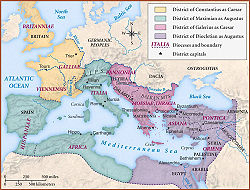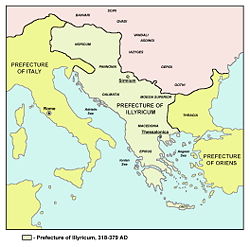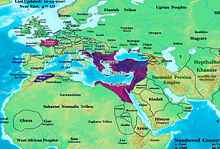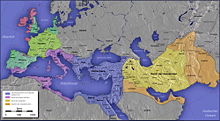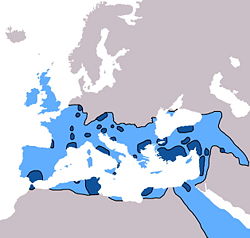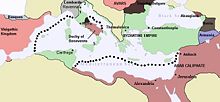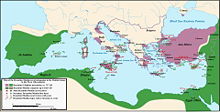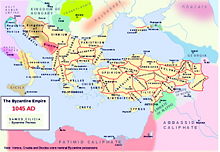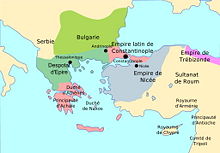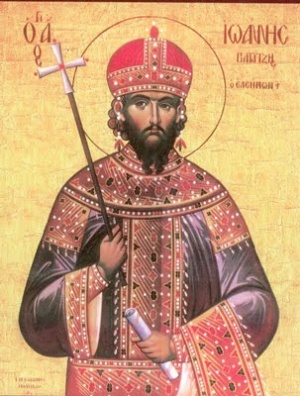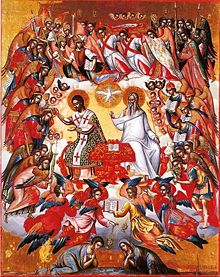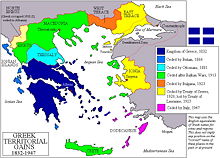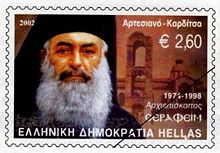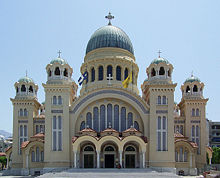Timeline of Orthodoxy in Greece
This is a timeline of the presence of Orthodoxy in Greece. The history of Greece traditionally encompasses the study of the Greek people, the areas they ruled historically, as well as the territory now composing the modern state of Greece.
Christianity was first brought to the geographical area corresponding to modern Greece by the Apostle Paul, although the church’s apostolicity also rests upon St. Andrew who preached the gospel in Greece and suffered martyrdom in Patras, Titus, Paul’s companion who preached the gospel in Crete where he became bishop, Philip who, according to the tradition, visited and preached in Athens, Luke the Evangelist who was martyred in Thebes, Lazarus of Bethany, Bishop of Kittium in Cyprus, and John the Theologian who was exiled on the island of Patmos where he received the Revelation recorded in the last book of the New Testament. In addition, the Theotokos is regarded as having visited the Holy Mountain in 49 AD according to tradition. Thus Greece became the first European area to accept the gospel of Christ. Towards the end of the 2nd century the early apostolic bishoprics had developed into metropolitan sees in the most important cities. Such were the sees of Thessaloniki, Corinth, Nicopolis, Philippi and Athens.[1]
By the 4th century almost the entire Balkan peninsula constituted the Exarchate of Illyricum which was under the jurisdiction of the bishop of Rome. Illyricum was assigned to the jurisdiction of the patriarch of Constantinople by the emperor in 732. From then on the Church in Greece remained under Constantinople till the fall of the Byzantine empire to the Turks in 1453. As an integral part of the Ecumenical Patriarchate the church remained under its jurisdiction up to the time when Greece won her freedom from Turkish domination.[1] During the Ottoman occupation up to "6,000 Greek clergymen, ca. 100 Bishops, and 11 Patriarchs knew the Ottoman sword".[2][3][4][5][6][7][8][note 1]
The Greek War of Independence of 1821-28, while leading to the liberation of southern Greece from the Turkish yoke, created anomalies in ecclesiastical relations, and in 1850 the Endemousa Synod in Constantinople declared the Church of Greece autocephalous.
In the twentieth century during much of the period of communism, the Church of Greece saw itself as a guardian of Orthodoxy. It cherishes its place as the cradle of the primitive church and the Greek clergy are still present in the historic places of Istanbul and Jerusalem, and Cyprus.[9] The autocephalous Church of Greece is organised into 81 dioceses, however 35 of these are nominally under the jurisdiction of the Ecumenical Patriarchate of Constantinople but are administered as part of the Church of Greece (except for the dioceses of Crete, the Dodecanese, and Mount Athos which are under the direct jurisdiction of the Patriarchate of Constantinople).
The Archbishop of Athens and All Greece presides over both a standing synod of twelve metropolitans (six from the new territories and six from southern Greece), who participate in the synod in rotation and on an annual basis, and a synod of the hierarchy (in which all ruling metropolitans participate), which meets once a year.[1]
Among the current concerns of the Church of Greece are the Christian response to globalization, to interreligious dialogue, and a common Christian voice within the framework of the European Union.[1]
The population of Greece is 11.1 million (UN, 2007), 98% of which are Greek Orthodox (CIA World Factbook).
Contents
Apostolic era (33-100)
- ca. 47-48 Apostle Paul's mission to Cyprus.
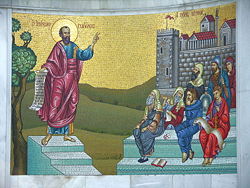
- ca. 49 Paul's mission to Philippi, Thessaloniki and Veria; Lydia of Thyatira was the Apostle Paul’s first convert to Christianity in Europe after hearing Paul’s words in Philippi proclaiming the Gospel of Christ during his second mission journey.
- 49 Paul's mission to Athens.
- ca. 51-52 Metropolis of Korinthos founded in its Apostolic during Paul's first mission to Corinth; Paul writes his two Epistles to the Thessalonians.
- ca. 54 Paul writes his First Epistle to the Corinthians.
- ca. 55 Paul revisits Corinth.
- ca. 56 Paul revisits Macedonia; he writes his Second Epistle to the Corinthians.
- ca. 61 Paul shipwrecked in Crete.
- 62 Crucifixion of Apostle Andrew in Patras.
- ca. 95 Apocalypse of John written on the island of Patmos.
- 96 Martyrdom of Dionysius the Areopagite of the Seventy.
- 100 Death of St. John the Theologian in Ephesus.
Ante-Nicene era (100-325)
- ca. 100 During the second and third centuries, Greece was divided into provinces including Achaea, Macedonia, and Moesia.
- ca. 120 Martyrdom of Eleutherios and his mother Anthia.
- 124 Apostles Quadratus and Aristides present Christian apologies to Emperor Hadrian at Athens.
- 128 Aquila's Greek translation of the Old Testament.
- ca. 130 Death of Apostle Quadratus, of the Seventy.
- 156 Martyrdom of Polycarp of Smyrna.
- 180-192 Theodotion's Greek translation of the Old Testament.
- 190 Death of Athenagoras of Athens, a Christian apologist who wrote in defense of the resurrection of the dead.
- 193-211 Symmachus' Greek translation of the Old Testament.
- 202 Death of Great Martyr Haralampos, Bishop of Magnesia.
- 210 Hippolytus of Rome, bishop and martyr and last of Greek-speaking fathers in Rome, writes Refutation of All Heresies (Philosophumena), and Apostolic Tradition.
- ca 250 Matrydom of Christopher of Lycia; martyrdom of Cyprian and Justina at Nicomedia; death of Hieromartyr Leonidas, Bp. of Athens.
- ca. 251 Martyric death of Isidore of Chios under the persecutions of Decius.
- 270 Death of Gregory the Wonderworker, founder of the Church in Cappadocia.
- 286 Martyrs Timothy and Mavra.
- 293 Emperor Diocletian institutes the Tetrarchy.
- 302 20,000 Martyrs burned at Nicomedia.
- 303 Death of Great-Martyr Panteleimon and martyrdom of George the Trophy-bearer at Nicomedia.
- 304 Death of Virgin-Martyr Anysia of Thessaloniki.
- 306 Martyric death of Demetrios in Thessaloniki.
- 306-37 Reign of Emperor Constantine the Great.
- ca. 306 Death of Great-Martyr Barbara of Nicomedia; death of Bp. Parthenios of Lampsacus.
- 311 Martyrdom of Bp. Methodius of Olympus.
- 313 Edict of Milan issued by Constantine the Great and co-emperor Licinius, officially declaring religious freedom in the Roman Empire.
- 314 Council of Ancyra held, the first post-persecution council.
- 316 Death of Blaise of Sebaste.
- 319 Matyrdom of Theodore Stratelates ("the General"), under Licinius.
Patriarchate of Rome Era (325-732)[note 2]
Nicene era (325-451)
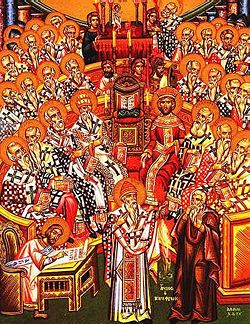
- 325 First Ecumenical Council held in Nicea, condemning Arianism, setting the Paschalion, and issuing the first version of the Nicene Creed, also establishing the supremacy of honor of the Apostolic Sees as Rome, followed by Alexandria, Antioch, and Jerusalem.
- 330 Byzantium refounded as Constantinople / New Rome, Christian capital of the Roman Empire, and is dedicated to the Theotokos by Emperor Constantine.
- 333 Constantine commissions Eusebius, to prepare 50 copies of the Bible for churches in the new capital.
- 335 Building of the Protaton church at Karyes (Athos) , dedicated to the Dormition of the Virgin Mary, oldest church on Mount Athos.
- ca. 330-337 Church of Panagia Ekatontapyliani - Hundred Doors (Paros) founded by St. Helen, during her pilgrimage to the Holy Land.
- 337 Under Constantine the Great Greece was part of the prefectures of Macedonia and Thrace.The Praetorian prefecture of Illyricum, ca. 357 AD, when the three dioceses of Macedonia, Dacia and Pannonia were first grouped together by Constantius II.
- 340-570 Constantinople overtakes Rome as the largest city in the world by population.
- 342 Death of Nicholas of Myra.
- 348 Death of Spyridon of Trimythous.
- ca.354 Emperor Constantius II sent the Arian bishop Theophilus "the Indian" on mission to south Asia via Arabia where he is said to have converted the Himyarites and built three churches in southwest Arabia; he is also said to have found Christians in India.
- 358 Basil the Great founds monastery of Annesos in Pontus, the model for Eastern monasticism.
- 359 Councils of Seleucia in the east and Rimini in the west.
- 360 First church of Hagia Sophia inaugurated by Emperor Constantius II.
- 364 Council of Laodicea held.
- 375 Basil the Great writes On the Holy Spirit, confirming the divinity of the Holy Spirit.
- 377 Epiphanius of Salamis (Cyprus) writes Panarion (Πανάριον, "Medicine Chest"), also known as Adversus Haereses ("Against Heresies"), listing 80 heresies, some of which are not described in any other surviving documents from the time .
- 378 Visigoths defeat Emperor Valens at the Battle of Adrianople, permanently weakening northern borders of the empire.
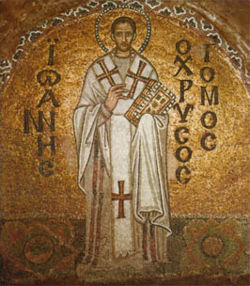 St. John Chrysostom, Abp. of Constantinople (398-404).
St. John Chrysostom, Abp. of Constantinople (398-404). - 379 Death of Basil the Great; the Cappadocian Fathers Basil the Great, Gregory of Nazianzus the Theologian, and Gregory of Nyssa set their mark on all subsequent history of the Greek churches, through Basil's On the Holy Spirit, and Rules; Gregory of Nazianzus' Five Theological Orations; and Gregory of Nyssa's polemical works against various heretical teachings.
- 380 Christianity established as the official faith of the Roman Empire by Emperor Theodosius the Great.
- 381 Second Ecumenical Council held in Constantinople, condemning Macedonianism/Pneumatomachianism and Apollinarianism, declaring the divinity of the Holy Spirit, confirming the previous Ecumenical Council, and completing the Nicene-Constantinopolitan Creed.
- ca. 383 First monastic institution established in Constantinople at Psamathia, outside the city.
- 386 Panagia Soumela Monastery founded in Trebizond, Pontus, Asia Minor, after St. Luke's Icon of the Mother of God appears at Mt. Mela.
- 391 Death of Gregory the Theologian.
- 391-92 Closing of all non-Christian temples in the Empire; Theodosius the Great ends pagan Eleusinian Mysteries by decree.
- 394 Epiphanius of Salamis (Cyprus) attacks teachings of Origen as heretical.
- 395 Death of Gregory of Nyssa; re-division of Empire with death of Emperor Theodosius the Great.
- ca. 395 Theodosius I divided the prefecture of Macedonia into the provinces of Creta, Achaea, Thessalia, Epirus Vetus, Epirus Nova, and Macedonia; the Aegean islands formed the province of Insulae in the prefecture of Asiana; the placing of the cincture (sash) of the Most Holy Theotokos in the Church of the Virgin in Halkoprateia-Constantinople (395-408).
- 398 John Chrysostom becomes Archbishop of Constantinople.
- 399 Death of Evagrius Ponticus, the first monk to write extensively on the spiritual life, influencing his students Palladius and John Cassian, Maximus the Confessor, Diadochus of Photike, Isaac of Nineveh, Symeon the New Theologian, and Gregory Palamas, among others.
- 403 Synod of the Oak held near Chalcedon, deposing and exiling John Chrysostom.
- 407 Death of John Chrysostom in exile.
- 421 Emperor of the east Theodosius II declares war on Persia when Persia begins persecuting Christians; the persection lasts until 457.
- 425 University of Constantinople founded as the first university in the world.
- 426 Euthymius the Great establishes lavra in Palestinian desert, consecrated in 428 by Bp. Juvenal of Jerusalem.
- 431 Third Ecumenical Council held in Ephesus, condemning Nestorianism and Pelagianism, confirming the use of the term Theotokos to refer to the Virgin Mary, and confirming autocephaly of Church of Cyprus.
- 437 Seven Sleepers of Ephesus awakened to prove resurrection of the dead.
- 438 Codex Theodosianus published; relics of John Chrysostom brought to Constantinople and buried in the Church of the Holy Apostles.
- 440 Death of Alexios the Man of God, Fool-for-Christ.
- 447 Earthquake in Constantinople, when a boy was lifted up to heaven and heard the Trisagion.
- 449 Robber Synod of Ephesus, presided over by Dioscorus of Alexandria, with an order from the emperor to acquit Eutyches the Monophysite.
Early Byzantine era (451-843)
- 451 Fourth Ecumenical Council meets at Chalcedon, condemning Eutychianism and Monophysitism, affirming doctrine of two perfect and indivisible but distinct natures in Christ, and recognizing Church of Jerusalem as patriarchate.
- 452 Second finding of the Head of John the Forerunner, at Emesa.
- 457 First coronation of Byzantine Emperor by patriarch of Constantinople; Proterius of Alexandria is lynched by an Alexandrian mob; rejecting the Christological definitions of Chalcedon, the Egyptian or Coptic church goes its own way, becoming one of the Oriental Orthodox Churches.
- 458 Death of Bp. Theodoret of Cyrrhus, influential author and theologian who played a pivotal role in many early Byzantine church controversies.
- 462 Indiction moved to September 1; Studion Monastery founded.
- 463 Death of Patapius of Thebes.
- ca.471 Patriarch Acacius of Constantinople was first called "Oikoumenikos" (Ecumenical).
- 484 Acacian Schism.
- 493 Death of Daniel the Stylite an ascetic who lived for 33 years on a pillar near the city of Constantinople.
- ca. 500 Zosimus, pagan Greek historian writes Historia Nova ("New History"), a history of the Roman Empire to 410 AD, with an anti-Christian view offering a different interpretation to church affairs than from Christian sources; Pseudo-Dionysius the Areopagite's writing corpus including the Divine Names, Mystical Theology, Celestial Hierarchy, and Ecclesiastical Hierarchy influences the development of Byzantine mystical spirituality and hesychasm through Maximus the Confessor, Symeon the New Theologian, and Gregory Palamas.
- ca.500-550 Andreas of Caesarea, Bp. of Caesarea in Cappadocia, writes the oldest surviving commentary on the Book of Revelation.
- 502 Start of Byzantine-Sassanid wars, lasting until 562.
- 518 Patriarch John II of Constantinople is addressed as "Oikoumenikos Patriarches" (Ecumenical Patriarch); the Byzantine government begins persecution of non-Chacedonians in the east, especially in Mesopotamia.
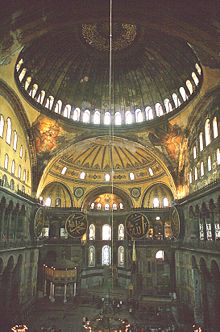
- 519 Eastern and Western churches reconciled with end of Acacian Schism.
- 520 Romanus the Melodist the greatest hymnographer, develops the Kontakion, a chanted verse sermon, to perfection; influenced by Ephrem the Syrian, he in turn influences Andrew of Crete.
- 529 Emperor Justinian closes the School of Athens, which Plato had founded in 387 BC.
- 529-534 Justinian's Corpus Juris Civilis issued, first comprehensive legal code in history of Roman Empire;; Justinian's Novella 131 formulated the proposed government of universal Christendom by five patriarchal sees under the auspices of a single universal empire (Pentarchy).
- 532 Justinian the Great orders building of Hagia Sophia;
- 537 Construction of Hagia Sophia in Constantinople completed; Justinian decrees that all dates must include the Indiction.
- ca. 540 Death of Osios David of Thessaloniki.
- 538 Emperor Justinian the Great, via deportations and force, manages to get all five patriarchates officially into communion.
- 540 Bulgar raids into Illyricum and northern Greece.
- 543 Doctrine of apokatastasis condemned by Synod of Constantinople; Justinian the Great sends missionaries to Nubia (the three kingdoms of Nobatia/Novatia, Alodia/Alwa, and Makuria).
- 544 According to tradition. the Mandylion of Edessa destroys Persian siege works.
- 553 Fifth Ecumenical Council held in Constantinople in an attempt to reconcile Chalcedonians with non-Chalcedonians—the Three Chapters of Theodore of Mopsuestia, Theodoret of Cyrrhus, and Ibas of Edessa are condemned for their Nestorianism, and Origen and his writings are also condemned.
- 553 Ostrogoth kingdom in Italy conquered by the Byzantine Empire after the Battle of Mons Lactarius.
- 556 Completion of Justinian the Great's fortification monastery of St. Catherine in the Sinai; a chapel and anchorites had already been there at least since the 4th century when Egeria visited in ca. 385.
- 557 Death of Cyriacus the Anchorite.
- 562 Isidorus of Miletus completes repair on dome of Hagia Sophia, now higher by 20 feet than the Anthemian original.
- 563 Re-consecration of Hagia Sophia in Constantinople after its dome is rebuilt.
- 565-66 Completion of the mosaic of the Transfiguration in apse of the Church of the Mother of God on Mt. Sinai.
- 565-78 The Cherubic Hymn was added to the Divine Liturgy by Emperor Justin II.
- 566 Bp. Longinus sent from Constantinople to Nubia as missionary.
- 568 Exarchate of Ravenna established, to 752, a Greek imperial outpost and place of contact with the Latin west.
- 575 The Chronographia (Χρονογραφία) of John Malalas in 18 books, chronicles the years from creation to 563 AD.
- 576 Dual hierarchy henceforth in Alexandria, Chalcedonian (Greek) and Monophysite (Coptic).
- 577 Patr. John III Scholasticus is responible for the first collection of Canon Law, the Nomocanon, of the Orthodox Church.
- 580 Serious invasion of Slavs migrating into the Balkans and Greece; last recorded persecution of pagans in Byzantine Empire.
- 582 Persection of Monophysites renewed under emperor Maurice.
- ca. 590 Parthenon in Athens converted into a Christian church dedicated to Agia Sophia.
- 594 Evagrius Scholasticus writes Ecclesiastical History, covering the years 431 to 594 AD.
- 586 St. Demetrios of Thessaloniki saves Thessaloniki from Avar-Slav siege.
- 602 Final series of wars between Byzantine Empire and Sassanid Empire.
- 610 Heraclius changes official language of the Empire from Latin to Greek, already the lingua franca of the vast majority of the population.
- 612 Holy Sponge and Holy Lance brought to Constantinople from Palestine.
- 617 Persian Army conquers Chalcedon after a long siege.
- 620 Slavs attack Thessaloniki.
- 626 Akathist Hymn to the [[|Theotokos|Virgin Mary]] written, after Constantinople liberated from a siege of 80,000 Avars, Slavs and the Persian fleet.
- 627 Emperor Heraclius decisively defeats Sassanid Persians at Battle of Nineveh, recovering True Cross and breaking power of the Sassanid dynasty.
- 630 Second Elevation of the Holy Cross, on March 21, 630 AD, when Emperor Heraclius entered Jerusalem amidst great rejoicing, and together with Patr. Zacharios (609-633), transferred the Cross of Christ with great solemnity into the |temple of the Resurrection; it is the first and only time a Byzantine emperor sets foot in the Holy Land.
- 632 Christian influences on Islamic practice include veiling of women, hospitality for monastic travellers, prostrations, facing east for prayer, fixed hours for daily office of prayer, ritual ablutions before worship.
- 633 Death of Patr. Modestus of Jerusalem, who had restored many buildings after the Persian sack of 614, including the rotunda of the Anastasis.
- 634 Emperor Heraclius issues edict ordering all Jews to be baptized; many Jews flee to protection of Persians or Muslim Arabs.
- 639 Death of Patr. Sophronius I of Jerusalem; his poetry and prayers become part of the Liturgy, including the Troparia of the Royal Hours of Holy Friday and on the eves of the Nativity and Theophany, and the main prayer of Great Blessing of Water on Epiphany.
- 641 St. Christopher of Trebizond heads the Monastery of Panagia Soumela (641-668).
- 646 Alexandria recaptured by Muslim Arabs after a Byzantine attempt to retake Egypt fails, ending nearly ten centuries of Greco-Roman civilization in Egypt; the monophysite Coptic patriarch Benjamin I and his followers willingly accepts Arab rule, preferring it to the Byzantines; Maximus the Confessor takes lead in opposing Monothelitism.
- 648 Pope Theodore I of Rome excommunicates patriarch Paul II of Constantinople.
- 649 Arabs invade and conquer Cyprus.
- 650 The Patriarchate of Constantinople counted 32 metropoles, or capitals of ecclesiastical provinces, 1 autocephalous metropolis, 34 autocephalous archbishoprics, and 352 bishoprics -- a grand total of 419 dioceses.
- 654 Invasion of Rhodes by Arabs.
- 662 Parthenon in Athens rededicated in honour of the Mother of God as "Panagia Atheniotissa" (Panagia of Athens), becoming the fourth most important pilgrimage site in the Eastern Roman Empire after Constantinople, Ephesus and Thessalonica;[10] death of Maximus the Confessor.
- 669-78 First Arab siege of Constantinople; at Battle of Syllaeum Arab fleet destroyed by Byzantines through use of Greek Fire, ending immediate Arab threat to eastern Europe.
- 680-681 Sixth Ecumenical Council held in Constantinople, condemning Monothelitism and affirming Christology of Maximus the Confessor, affirming that Christ has both a human will and a divine will; Patr. Sergius I of Constantinople and Pope Honorius I of Rome are both explicitly anathematized for their support of Monothelitism.
- 685 First monastics come to Mount Athos; emperor Justinian II is the first emperor to have the figure of the Lord Jesus Christ stamped on a coin.
- 688 Emperor Justinian II and Caliph al-Malik sign treaty neutralizing Cyprus.
- 692 The "Pentarchy" form of government of universal Christendom by five patriarchal sees received formal ecclesiastical sanction at the Council in Trullo, held in Constantinople, which ranked the five sees as Rome, Constantinople, Alexandria, Antioch, and Jerusalem.
- 705 Long period of fighting begins between Trebizond in eastern Asia Minor and the Arabs.
- 706 Greek replaced by Arabic as administrative language in Egypt.
- 707 Byzantines lose Balearic Islands to Moors;
- 710 Pope Constantine makes last papal visit to Constantinople before 1967.
- 712 Death of Andrew of Crete.
- 717-18 Second Arab siege of Constantinople.
- 720 Martyrdom of Nicholas the New of Vounina.
- 726 Iconoclast Emperor Leo the Isaurian starts campaign against icons.
Patriarchate of Constantinople Era (732-1850)

- 732-33 Byzantine Emperor Leo the Isaurian transfers Southern Italy (Sicily and Calabria), Greece, and the Aegean from the jurisdiction of the Pope to that of the Ecumenical Patriarch in response to Pope St. Gregory III of Rome's support of a revolt in Italy against iconoclasm, adding to the Patriarchate about 100 bishoprics; the Iconoclast emperors took away from the Patriarch of Antioch 24 episcopal sees of Byzantine Isauria, on the plea that he was a subject of the Arab caliphs; the jurisdiction of the Patriarch of Constantinople became co-extensive with the limits of the Byzantine Empire.
- 734 Death of Peter the Athonite, commonly regarded as one of the first hermits of Mount Athos.
- 739 Emperor Leo III (717-41) publishes his Ecloga , designed to introduce Christian principle into law; Byzantine forces defeat Umayyad invasion of Asia Minor at Battle of Akroinon.
- 746 Byzantine forces regain Cyprus from the Arabs.

- 754 Iconoclastic Council held in Constantinople under the authority of Emperor Constantine V Copronymus, condemning icons and declaring itself to be the Seventh Ecumenical Council; Constantine begins dissolution of the monasteries.
- 764 Martyrdom of Stephen the New (Stephen the Younger), Byzantine monk from Constantinople who became one of the leading opponents of the iconoclastic policies of Emperor Constantine V.
- 787 Seventh Ecumenical Council held in Nicea, condemning iconoclasm and affirming veneration of icons.
- 789 Death of Philaret the Merciful.
- 803 Death of Irene of Athens, wife of Byzantine Emperor Leo IV; St. Luke's icon brought to Agiassos on Mytiline.
- 814 Bulgarians lay siege to Constantinople; conflict erupts between Emperor Leo V and Patr. Nicephorus on the subject of iconoclasm; Leo deposes Nicephorus, Nicephorus excommunicates Leo.
- 816 Death of Gregory the Decapolite (November 20).
- 824 Byzantine Crete falls to Arab insurgents fleeing from the Umayyad Emir of Cordoba Al-Hakam I, establishing an emirate on the island until the Byzantine reconquest in 960.
- 826 Death of Theodore the Studite.
- 828 Death of Patr. Nicephorus I of Constantinople.
- 838 Caliph al-Mu'tasim captures and destroys Ammoria in Anatolia.
- ca. 839 First Rus'-Byzantine War, where the Rus attacked Propontis (probably aiming for Constantinople) before turning east and raiding Paphlagonia.
- 840 Panagia Prousiotissa icon found near Karpenissi.
Byzantine Imperial era (843-1204)
- 843 Empress Theodora secures return of icon-worship with Triumph of Orthodoxy occuring on first Sunday of Great Lent, restoring icons to churches.
- 845 42 Martyrs of Ammoria in Phrygia taken as hostages from Ammoria to Samarra (in Iraq) and executed there.
- 850 Third Finding of the head of John the Forerunner.
- 858 Photius the Great becomes patriarch of Constantinople.
- 860 Second Rus-Byzantine War, a naval raid and the first siege of Constantinople by the Rus.
- ca. 860 Christianization of the Rus' Khaganate.
- 861 Cyril and Methodius of Thessaloniki depart from Constantinople to missionize the Slavs; Council of Constantinople attended by 318 fathers and presided over by papal legates confirms Photius the Great as patriarch and passes 17 canons.
- 864 Baptism of Prince Boris I of Bulgaria; Synaxis of the Theotokos in Miasena in memory of the return of her icon.
- 867 Council in Constantinople held, presided over by Photius, which anathematizes Pope Nicholas I of Rome for his attacks on work of Greek missionaries in Bulgaria and use by papal missionaries of Filioque; Pope Nicholas dies before hearing news of excommunication; Basil the Macedonian has Emperor Michael III murdered and usurps Imperial throne, reinstating Ignatius as patriarch of Constantinople.
- 867 Death of Kassiani, Greek-Byzantine poet and hymnographer, who composed the Hymn of Kassiani, chanted during Holy Week on Holy Wednesday.
- 869-870 Robber Council of 869-870 held, deposing Photius the Great from the Constantinopolitan see and putting the rival claimant Ignatius on the throne, declaring itself to be the "Eighth Ecumenical Council."
- 870 Conversion of Serbia; Malta conquered from the Byzantines by the Arabs.
- 874 Translation of relics of Nicephorus the Confessor, interred in the Church of the Holy Apostles, Constantinople.
- 877 Death of Ignatius of Constantinople, who appoints Photius to succeed him; Arab Muslims conquer all of Sicily from Byzantium and make Palermo their capital.
- 879-880 Eighth Ecumenical Council held in Constantinople attended by 383 fathers passing 3 canons, confirms Photius as Patriarch of Constantinople, anathematizes additions to the Nicene-Constantinopolitan Creed, and declares that the prerogatives and jurisdiction of the Roman pope and the Constantinopolitan patriarch are essentially equal; the council is reluctantly accepted by Pope John VIII of Rome.
- 881 Death of Theoktiste of Lesbos.
- 885 Mount Athos gains political autonomy, as Emperor Basil lays down the boundaries of the monastic republic; death of Methodius.
- 892 Death of Theodora the Myrrh-gusher of Thessaloniki.
- 902 Taormina, the last Byzantine stronghold in Sicily, is captured by the Aghlabid Arabs.
- 904 Thessaloniki sacked and pillaged by Saracen pirates under Leo of Tripoli, a Greek pirate serving Saracen interests.
- 907 Third Rus-Byzantine War, a naval raid of Constantinople (or Tsargrad in Old Slavonic) led by Varangian Prince Oleg of Novgorod, which was relieved by peace negotiations.
- 911 Holy Protection of the Virgin Mary; Russian envoys visit Constantinople to ratify a treaty, sent by Oleg, Grand Prince of Rus'.
- 912 Nicholas I Mysticus becomes Patriarch of Constantinople.
- 921 Death of Irene Chrysovalantou.
- 925 Death of Bp. Peter of Argos, whose writings appear in Patrologia Graeca.
- 941 Fourth Rus-Byzantine War.
- 944 City of Edessa recovered by Byzantine army, including Icon Not Made By Hands.
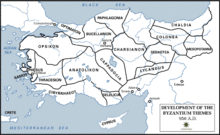
- 953 Monastery of Hosios Loukas founded by St. Luke the Younger near Stiris (Thebes) in Greece.
- 957 Olga of Kiev baptized in Constantinople.
- 960 Emperor Nicephorus II Phocas re-captures Crete for the Byzantines.
- 961 Founding of Agia Lavra monastery in Kalavryta, Peloponesse, (the symbolic birth-place of modern Greece in 1821).
- 963 Athanasius of Athos establishes first major monastery on Mount Athos, the Great Lavra; founding of Philosophou Monastery in Dimitsana (Peloponesse); death of Michael Maleinos, a Byzantine monk who commanded great respect among Christians of Asia Minor, and was later adopted as a patron saint of Mikhail Feodorovich, the first Romanov tsar.
- ca.963-1018 The Chronicle of Monemvasia is composed, narrating the events that depict the Avaro-Slavic conquest and colonization of mainland Greece, covering a period from 587 to 805 AD.
- 965 Emperor Nicephorus II Phocas gains Cyprus completely for the Byzantines.
- 968-71 Fifth Rus-Byzantine War, resulting in a Byzantine victory over the coalition of Rus', Pechenegs, Magyars, and Bulgarians in the Battle of Arcadiopolis, and the defeat of Sviatoslav of Kiev by John I Tzimiskes.
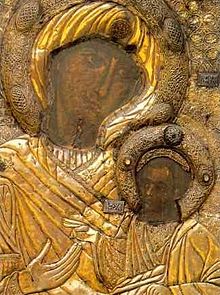 Panagia Portaitissa (Iviron Monastery, Athos).
Panagia Portaitissa (Iviron Monastery, Athos). - 969 Emperor Nicephorus II Phocas captures Antioch and Aleppo from Arabs.
- 972 Emperor John I Tzimiskes grants Mount Athos its first charter (Typikon).
- 975 Emperor John I Tzimiskes in a Syrian campaign takes Emesa, Baalbek, Damascus, Tiberias, Nazareth, Caesarea, Sidon, Beirut, Byblos and Tripoli, but fails to take Jerusalem.
- 980 Revelation of the Axion Estin (the hymn "It Is Truly Meet"), with the appearance of the Archangel Gabriel to a monk on Mount Athos.
- 980-983 Iviron Monastery is built under the supervision of Ioannes the Iberian and Tornikios.
- 987 Sixth Rus-Byzantine War, where Vladimir of Kiev dispatches troops to the Byzantine Empire to assist Emperor Basil II with an internal revolt, agreeing to accept Orthodox Christianity as his religion and bring his people to the new faith.
- 988 Baptism of Rus' begins with the conversion of Vladimir of Kiev who is baptized at Chersonesos, the birthplace of the Russian and Ukrainian Orthodox churches; Vladimir marries Anna, sister of Byzantine emperor Basil II.
- ca.990 Bp. Œcumenius of Trikka (now Trikkala) in Thessaly writes several commentaries on books of the New Testament.
- ca.992 Greek monk and wonderworker St. Sergius of Valaam co-founded the Valaam Monastery (along with Herman of Valaam), in Russian Karelia on Valaam island, and is credited with bringing Orthodox Christianity to the Karelian and Finnish people.
- 998 Death of Nikon Metanoeite ("preacher of repentance").
- ca.999 Icon of the Panagia Portaitissa appears on Mount Athos near Iviron monastery.
- 10th c. Paris Psalter produced, a Byzantine illuminated manuscript containing 449 folios and 14 full-page miniatures "in a grand, almost classical style", considered a key monument of the so-called Macedonian Renaissance in Byzantine art.
- 11th c. Kaisariani Monastery is founded on the slopes of Mount Hymettos, one of the oldest and most important monasteries in Attica; death Theodora of Vasta.
- 1004 Nilus the Younger, born to a Greek family in the Byzantine Theme of Calabria, founds the famous Greek Basilian monastery of Grottaferrata, becoming the first abbott.
- 1009 Patr. Sergius II of Constantinople removes name of Pope Sergius IV of Rome from diptychs of Constantinople, because the pope had written a letter to the patriarch including the Filioque.
- 1018 Emperor Basil II went on a pilgrimage to Athens directly after his final victory over the Bulgarians for the sole purpose of worshipping at the Parthenon.[10]
- 1022 Death of Symeon the New Theologian.
- 1025 Greece is divided into themes including Crete, the Peloponnese, Hellas, Nicopolis, Larissa, Cephalonia, Thessalonica, the Cyclades and the Aegean.
- 1034 Patriarch Alexius I Studites writes the first complete Studite Typikon, for a monastery he established near Constantinople; this was the Typikon introduced into the Rus' lands by Theodosius of the Kiev Caves.
- 1042 Founding of Nea Moni Monastery on Chios.
- 1043 University of Constantinople is re-organized under Michael Psellos.
- 1053 Death of Lazarus the Wonder-worker of Mount Galesius near Ephesus.
- 1054 The Great Schism between Orthodox East and Latin West.
- 1068 By the time of the arrival of the first Seljuk Turks to Anatolia, the religious war between Byzantium and Islam had run a course of four centuries.
- 1071 Seljuk Turks defeat Byzantines at the Battle of Manzikert, beginning Islamification of Asia Minor; Norman princes led by Robert Guiscard capture Bari, the last Byzantine stronghold in Italy, bringing to an end over five centuries of Byzantine rule in the south.
- ca. 1071-1176 Byzantine epic poem "Digenes Akrites" is written, set in the ninth and tenth centuries, inspired by the almost continuous state of warfare with the Arabs in eastern Asia Minor, presents a comprehensive picture of the intense frontier life of the Akrites, the border guards of the Byzantine Empire.
- 1073 Seljuk Turks conquer Ankara.
- 1077 Seljuks capture Nicea.
- 1087 Translation of the relics of Nicholas of Myra from Myra to Bari.
- 1083 Metropolis of Paronaxia separates from the Metropolis of Rhodes.
- 1088-93 Emperor Alexios Komnenos I gave the island of Patmos to Blessed Christodoulos of Patmos to develop as an independent monastic state; founding of monastery of John the Theologian on Patmos.
- 1093 Death of Christodoulos the Wonderworker of Patmos.
- 1118-1137 Imperial monastery of Christ Pantocrator founded.
- 1127-1145 Constantinople largest city in the world by population.
- 1147 Roger II of Sicily takes Corfu from the Byzantine Empire, and pillages Corinth, Athens and Thebes.
- 1176 Sultanate of Rum defeats Byzantine Empire in the Battle of Myriokephalon, marking end of Byzantine attempts to recover Anatolian plateau.
- 1192-1571 Church of Cyprus is subordinated to a Latin Hierarchy established by the Crusaders.
- 12th c. Skete life begins in Meteora.
Latin Occupation (1204-1456)
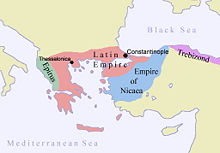
- 1204 Fourth Crusade sacks Constantinople, laying waste to the city and stealing many relics and other items; Great Schism generally regarded as having been completed by this act; Venetians use the imperial monastery of Christ Pantocrator as their headquardters in Constantinople.
- 1204 Latin Occupation of mainland Greece under Franks and Venetians: the Latin Empire of Constantinople, Latin Kingdom of Thessalonica, the Principality of Achaea, and the Duchy of Athens; The Venetians controlled the Duchy of the Archipelago in the Aegean.
- 1205 Latins annex Athens and convert the Parthenon into a Roman Catholic Church - Santa Maria di Athene, later Notre Dame d'Athene.
- 1211 Venetian crusaders conquer Byzantine Crete, retaining it until ousted by Ottoman Turks in 1669.
- 1224 The Byzantines recover Thessaloniki and surrounding area, liberated by the Greek ruler of Epirus Theodore Ducas Comnenus.
- 1235 St. Olympiada and nuns martyred by pirates on Mytilene of Lesbos
- 1249 Mystras citadel built by Franks in the Peloponnese.
- 1258 Michael VIII Palaiologos seizes the throne of the Nicaean Empire, founding the last Roman (Byzantine) dynasty, beginning reconquest of Greek peninsula from Latins.
- 1259 Byzantines defeat Latin Principality of Achaea at the Battle of Pelagonia, marking the beginning of the Byzantine recovery of Greece.
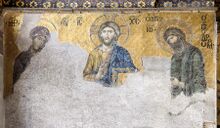
- ca. 1259-80 Martyrdom by Latins of monks of Iveron Monastery.
- 1261 End of Latin occupation of Constantinople and restoration of Orthodox patriarchs; Emperor Michael VIII Palaiologos makes Mystras seat of the new Despotate of Morea, where a Byzantine renaissance occurred.
- 1265-1310 Arsenite Schism of Constantinople, beginning when Patr. Arsenius Autoreianos excommunicated emperor Michael VIII Palaiologos.
- 1274 Orthodox attending the Second Council of Lyons, accept supremacy of Rome and filioque clause.
- 1275 Unionist Patr. of Constantinople John XI Beccus elected to replace Patr. Joseph I Galesiotes, who opposed Council of Lyons.
- 1275 Persecution of Athonite monks by Emp. Michael VIII and Patr. John XI Beccus; death of 26 martyrs of Zographou monastery on Mount Athos, martyred by the Latins.
- 1279 Hieromonk Ieronymos Agathangelos writes an Apocalypse dealing with the destinies of the nations.[note 3]
- 1281 Pope Martin IV authorizes a Crusade against the newly re-established Byzantine Empire in Constantinople, excommunicating Emperor Michael VIII Palaiologos and the Greeks and renouncing the union of 1274; French and Venetian expeditions set out toward Constantinople but are forced to turn back in the following year due to the Sicilian Vespers.
- 1283 Accommodation with Rome officially repudiated.
- 1287 Last record of Western Rite Monastery of Amalfion on Mount Athos.
- 14th c. "Golden Age" of Thessaloniki in both literature and art, many churches and monasteries built.
- 1300-1400 The "Chronicle of Morea" (Το χρονικό του Μορέως) narrates events of the establishment of feudalism in mainland Greece, mainly in the Morea/Peloponnese, by the Franks following the Fourth Crusade, covering a period from 1204 to 1292.
- 1309 Rhodes falls to the Knights of St. John, who establish their headquarters there, renaming themselves the "Knights of Rhodes".
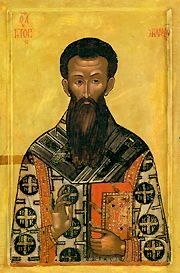
- 1310 Arsenite Schism of Constantinople is brought to an end by the reconciliation of the Arsenites to the Josephites.
- 1326 The city of Prusa in Asia Minor falls to the Ottoman Turks after a nine-year siege.
- 1331 The city of Nicaea, capital of the Empire only 100 years previously, falls to the Ottoman Turks.
- 1336 Meteora in Greece are established as a center of Orthodox monasticism.
- 1337 Nicomedia captured by Ottoman Turks.
- 1338 Gregory Palamas writes Triads in defense of the Holy Hesychasts, defending the Orthodox practice of hesychast spirituality and the use of the Jesus Prayer.
- 1341-47 Byzantine civil war between John VI Cantacuzenus (1347–54) and John V Palaeologus (1341–91).
- 1341-51 Three sessions of the Ninth Ecumenical Council held in Constantinople, affirming hesychastic theology of Gregory Palamas and condemning rationalistic philosophy of Barlaam of Calabria.
- ca.1351 Holy Royal Patriarchal Stavropegic Monastery of the Vlatades (Moni Vlatadon) is founded in Thessaloniki.
- 1354 Ottoman Turks make first settlement in Europe at Gallipoli.
- 1359 Death of Gregory Palamas.
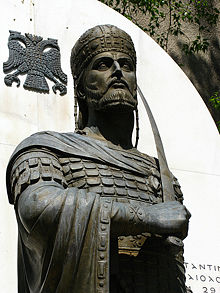 The right-believing Emperor Constantine XI Palaiologos the Ethnomartyr.
The right-believing Emperor Constantine XI Palaiologos the Ethnomartyr. - 1360 Death of John Koukouzelis the Hymnographer.
- 1365 Ottoman Turks made Adrianople their capital.
- 1382 Founding of the Great Meteora Monastery.
- 1386-87 Church of St Athanasius of Mouzaki built in Kastoria, Greece, the last church built in Kastoria before its annexation by the Ottoman Empire.
- 1390 Ottomans take Philadelphia, last significant Byzantine enclave in Anatolia.
- ca.1391 Death of Nicholas Cabasilas, well known theological writer and mystic of the Orthodox Church who took the side of the monks of Mount Athos and St Gregory Palamas in the Hesychast controversy.
- 1391-98 Ottoman Turks unsuccessfully besiege Constantinople for the first time.
- 1411 Death of Niphon of Mount Athos, proponent of hesychastic theology and wonderworker.
- 1422 Second unsuccessful Ottoman siege of Constantinople.
- 1426 Death of New Martyr Ephraim of Nea Makri (a "newly revealed" ("νεοφανείς") saint in 1950).
- 1429 The Turks capture Thessaloniki.
- 1430 The monks of Mount Athos submit to Sultan Murad II and keep their autonomy.
- 1438 Council of Florence unsuccessfully tries to unit Greek East and Latin West.
- 1450 Death of Empress Helena Palaeologus (St. Ipomoni of Loutraki).
- 1452 Unification of Roman Catholic and Greek Orthodox Churches in Hagia Sophia on West's terms, when Emperor Constantine XI Palaiologos, under pressure from Rome, allows the union to be proclaimed.
- 1453 Constantinople falls to invasion of the Ottoman Turks, ending Roman Empire; Hagia Sophia turned into a mosque; martyrdom of Constantine XI Palaiologos, last of the Byzantine Emperors; many Greek scholars escape to the West with books that become translated into Latin, triggering the Renaissance; beginning of the genre of lamentation folk songs known as "Moirologia", or dirges (Byzantine secular music).
Ottoman Turkish Occupation (1456-1821)

- 1456 Turkish Occupation of Greece.
- 1456-1587 Byzantine Church of Theotokos Pammakaristos became the seat of the Ecumenical Patriarchate.
- 1460 Parthenon Cathedral dedicated to the Mother of God turned into a mosque.
- 1462 Wonderworking icon of the Archangel Michael of Mantamados is created; Matrona of Chios reposes October 22.
- 1463 Martyric death of Raphael, Nicholas and Irene on Mytilene (Lesvos).
- 1472 Decrees of the Council of Ferrara-Florence repudiated by Patriarchate of Contantinople.
- 1511 Death of Joseph the Sanctified of Crete.
- 1530 Mother of God restores sight to blind youth through the Cassiope icon of Corfu.
- 1546 New Martyr John of Ioannina.
- 1554 New Martyr Nicholas of Korinth.
- 1556 Death of Maximus the Greek.
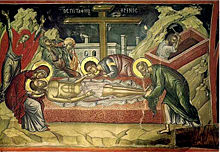
- 1556-65 The Patriarchal School of Joasaph II is initially established in Constantinople, the forerunner of the Great School of the Nation (I Megali tou Genous Sxoli / Η Μεγάλη του Γένους Σχολή).
- 1559 Death of Iconographer Theophanes the Cretan.
- 1571 Restoration of Church of Cyprus to Orthodox rule.
- 1573 The Church of San Giorgio dei Greci is completed by the Greek community of Venice, the oldest and historically most important church of the Greek Orthodox Diaspora, becoming the ethnic and religious center of Hellenism in the city and broader region of Venice which at its peak numbered 15,000 members.
- 1573-81 Correspondence between Patriarch Jeremias II and the Lutheran professors at Tubingen.
- 1574-82 Michael Damaskinos, the greatest Cretan iconographer of the day, paints the iconostasis of the Church of San Giorgio dei Greci in Venice.
- 1576 Pope Gregory XIII establishes Pontifical Greek College of St. Athanasius (popularly known as the 'Greek College') in Rome, which he charged with educating Italo-Byzantine clerics.
- 1579 Death of Gerasimos of Cephalonia.
- 1583 Sigillion of 1583 issued against Gregorian Calendar by council convened in Constantinople.
- 1587-Present. The relatively modest Church of St George in the Phanar district of Istanbul becomes the seat of the Ecumenical Patriarchate.
- 1589 Death of Philothei of Athens; death of David of Euboea the Wonderworker.
- 1590 Death of Timothy of Penteli (Athens).
- 1596 Death of Nilus the Myrrh-gusher of Mt. Athos.
- 1601 New Hieromartyr Seraphim, Bishop of Phanarion and Neokhorion.
- 1602 Seraphim of Lebadeia
- 1622 Death of Dionysius of Zakynthos (December 17).
- 1625 The Patriarchal School (Great School of the Nation) opened again under the direction of Theofilos Korydaleas having many students, however Korydaleas' liberal ideas caused the school's closure; Confession of Faith by Metrophanes Kritopoulos written.
- 1638 First translation of the New Testament into Modern Greek, by the Greek hieromonk Maximos Rodios of Gallipoli (Kallioupolitis).
- 1650-1700 Ottoman Constantinople is largest city in the world by population.
- 1657 New Hieromartyr Parthenius III, Patriarch of Constantinople.
- 1662 The Patriarchal School (Great School of the Nation) acquired permanent income, a building and remarkable teachers, among them Alexandros Mavrokordatos who bore the title Confidant.
- 1669 Greek island of Crete taken by Ottoman Empire from Venetians; martyrdom of John Naukliros.
- 1677 Bishop Henry Compton of London builds church for the Greeks in London.
- 1682 Greek church in London closed.
- 1684 New Hieromartyr Zacharias, Bishop of Corinth.
- 1687 Parthenon devastated by Venetian shelling.
- 1694 Plan for Worcester College, Oxford (then Gloucester Hall) to become a college for the Greeks.
- 1695 New Hieromartyr Romanos of Diminitzas, Lacedemonia.
- 1713 Theological School of Patmos founded.
- 1716 Miracle of St. Spyridon, who saves Corfu from Turkish invasion.
- 1720 Monastery of the Life-Giving Spring (Poros) founded.
- 1728 The Ecumenical Patriarchate formally replaced the Creation Era (AM) calendar, in use for over 1000 years, with the Christian Era (AD).
- 1730 Death of John the Russian.
- 1735 Death of Athanasius the New, Wonderworker of Christianopolis.

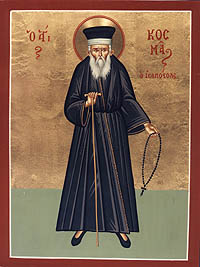
- 1740 Miracle performed by the glorious Prophet and Forerunner John the Baptist, on the island of Chios.
- 1741 Synodal reform initiated, when Metr. Gerasimos of Heraclia obtains a Firman (decree) from Ottoman officials, regulating and subordinating the election of the Patriarch of Constantinople to the five Metropolitans of Heraclia, Kyzikos, Nicomedia, Nicaea, and Chalcedon, creating the so-called System of the Elders (Γεροντισμος), established gradually, in place until the late 19th century.
- 1743 New Hieromartyr Anastasios of Ioannina.
- 1749 Athonite Ecclesiastical Academy ("Athonite School") is founded on Mount Athos by the brethren of the Monastery of Vatopedion.
- 1751 New Virgin Martyr Kyranna of Thessalonica.
- 1753-59 Eminent theologian and scholar Eugenios Voulgaris heads the Athonite School, envisaging a revivial and upgrading of learning within the Orthodox Church through substantial training in the classics combined with an exposure to modern European philosophy.
- 1754 Hesychast Renaissance begins with the Kollyvades Movement; most of the Kollyvades were men of high intellectual caliber, educated in ancient Greek and Christian literatures and well versed in the Biblical and Patristic sources of the church; among them were St. Makarios of Corinth, Christophoros of Arta, Agapios of Cyprus, Athanasius Parios, Neophytos Kausokalyvites, and also St. Nicodemus the Hagiorite; discovery of the holy relics of the Four Martyrs of Megara: Polyeuctos, George, Adrianos and Platon, the "Newly-Revealed".
- 1756 Sigillion of 1756 issued against the Gregorian Calendar by Patr. Cyril V of Constantinople.
- 1759 School on Mount Athos forced to close down.
- 1768 Community of Orthodox Greeks establishes itself in New Smyrna, Florida.
- 1770 Cretan insurrection against the Ottomans led by Ioannis Daskalogiannis of the Sfakia region is subjugated; Hieromartyr George of Neapolis.
- 1779 Death of Kosmas Aitolos, Equal to the Apostles.
- 1782 First publication of Philokalia on Mount Athos; New Martyr Zacharias of Patra in Morea.
- 1793 New Martyr Polydorus of Cyprus.
- 1794 Glorification of Bp. Panaretos of Paphos (+1790); new martyr Alexander the former Dervish;
- 1795 New Martyr Theodora of Byzantium (Mytiline).
- 1796 Nicodemus the Hagiorite publishes Unseen Warfare in Venice.
- 1798 Patriarch Anthimus of Jerusalem contended that the Ottoman Empire was part of the Divine Dispensation granted by God to protect Orthodoxy from the taint of Roman Catholicism and of Western secularism and irreligion.
- 1800 The Rudder published and printed in Athens; Death of Hieromonk Nikephoros Theotokis, "Teacher of the Nation".
- 1802 New Martyr Luke of Mytilene.
- 1803 Dance of Zalongo.
- 1805 Death of Makarios of Corinth, a central figure in the Kollyvades Movement.
- 1808 New Hieromartyr Nicetas of Serres.
- 1809 Death of Nicodemus of the Holy Mountain the "Hagiorite"; Hieromartyr Nicetas the Hagiorite.
- 1813 Death of Athanasius Parios, the second leader of the Kollyvades movement, succeeding Neophytos Kausokalyvites (1713-1784).
- 1814 Martyrdom of Euthymius and Ignatius of Mount Athos.
- 1816 Martyrdom of Acacius of Athos.
- 1819 Council at Constantinople endorses views of Kollyvades fathers.
Greek War of Independence (1821-1829)
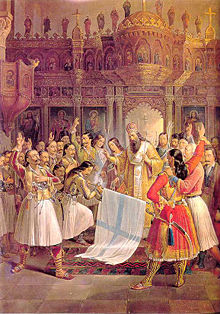
- 1821 Greek War of Independance begins as Metr. Germanos of Patra declares Greek independence on Day of Annunciation (March 25), also Kyriopascha, at the Monastery of Agia Lavra, Peloponessos; martyrdom of Patr. Gregory V of Constantinople, Abp. Kyprianos of Cyprus, and Abp. Gerasimos of Crete in retaliation; Former Ecumenical Patr. Cyril VI of Constantinople is hanged at the gate of Adrianople's cathedral; Metropolitans Gregorios of Derkon, Dorotheos of Adrianople, Ioannikios of Tyrnavos, and Joseph of Thessaloniki are decapitated on Sultan orders in Constantinople; Metropolitans Chrysanthos of Paphos, Meletios of Kition and Lavrentios of Kyrenia are executed in Nicosia, Cyprus; liberation fighters started calling themselves "Hellenes" (for continuity with their ancient Hellenic heritage), rather than using the generic "Romioi" (Ρωμιοί) (which referred to both their Roman citizenship and religious affiliation to Orthodox Christendom); death of Nikephoros of Chios.

- 1823 Wonderworking Icon of Panagia Evangelistria found on Tinos, led by a vision from Pelagia of Tinos, becoming the most venerated pilgrimage item in Greece, at the Church of Evangelistria; martyrdom of Hieromonk Christos of Ioannina.
- 1825 Archimandrite Gregorios Dikaios ("Papaflessas") is killed during the Battle of Maniaki on June 20, fighting against the forces of Ibrahim Pasha at Maniaki, Messenia.
- 1827 Europe recognises the autonomy of Greece.
- 1828 John Capodistrias first president of Greece and confiscates Athonite metochia; Greek church opened in London (2nd time).
- 1829 Treaty of Adrianople ends Greek War of Independence, culminating in the creation of the modern Greek state.
First Hellenic Republic (1829-1832)
- ca. 1829 The purified and formal Katharevousa language of Modern Greek is promoted as the official language (to 1976).
- 1830 The fully sovereign status of Greece was accepted in the London Protocol of February 3, 1830; Greece grants citizenship to Jews.
- 1832 Treaty of Constantinople, European powers establish Greek protectorate; Otho I enthroned as Greek King.
Kingdom of Greece (1833-1924)
- 1832-35 "Bavarokratia" closes down 600 monasteries and nationalises monastic land-holdings
- 1833 The National Assembly at Nauplio declares the Church of Greece as independant from the Ecumenical Patriarchate of Constantinople
- 1834 Suppression of many monasteries in the new Greek kingdom.
- 1835 On February 2 the Ecumenical Patriarch Constantius II of Constantinople (1834-35) celebrating with 12 bishops and an enormous flood of the faithful, consecrated the Church of the Life-Giving Font dedicating it to the Most Holy Theotokos.
- 1837 School of Theology at the National and Capodistrian University of Athens founded.
- 1838 Council of Constantinople held, attended by Patriarchs Gregory VI of Constantinople and Athanasius V of Jerusalem, whose main theme was the Unia, and the extermination of Latin dogmas and usages;[12] death of New Martyr George of Ioannina.
- 1839 Theofilos Kairis of Andros condemned and imprisoned for teaching a form of Deism.
- 1843 Georgios Rizaris, a benefactor, merchant, and member of the Filiki Eteria organization, funded the building of the Rizareios Ecclesiastical School in Athens, which continues to function as a religious and educational institution today, based in Halandri, Athens.
- 1844 Prime Minister Ioannis Kolettis first coined the expression the "Great Idea" (Megali Idea), envisaging the restoration of the Christian Orthodox Byzantine Empire with its capital once again established at Constantinople, becoming the core of Greek foreign policy until the early 20th century; King Otho I accepts constitution.
- 1845 Death of priest and scholar Neophytos Doukas, author of a large number of books and translations of ancient Greek works, and one of the most important personalities of the Greek Enlightenment during the Ottoman occupation of Greece.
Autocephalous Era (1850-Present)
- 1850 Endemousa Synod in Constantinople presided over by by Patriarch Anthimos IV of Constantinople recognised Autocephaly of the Church of Greece; due to certain conditions issued in the "Tomos" decree, the Greek National Church must maintain special links to the "Mother Church".
- 1856 Death of Neophytus Vamvas, Greek cleric and educator who had translated the Bible into Modern Greek.
- 1857-66 J.P. Migne produces the Patrologia Graeca in 161 volumes, including both the Eastern Fathers and those Western authors who wrote before Latin became predominant in the Western Church in the 3rd century.
- 1863 George I enthroned as King of Greece.
- 1864 Holy Trinity Church, first Orthodox parish established on American soil in New Orleans, Louisiana, by Greeks.
- 1866 Greek church takes the diocese of the Ionian Islands from Constantinople; beginning of the Great Cretan Revolution (1866-1869); the holocaust of Arkadi Monastery in Crete.
- 1871 Body of Patriarch Gregory V returned to Athens and entombed in cathedral.
- 1877 Death of Arsenios of Paros (August 18).
- 1878 Council of Athens, convened and presided over by Metropolitan Procopius I of Athens, condemned the Makrakists, obtaining closure of Apostolos Makrakis' "School of the Logos" on the pretext that it taught doctrines opposed to the tenets of the Church, and addressed an encyclical to the whole body of Christians in Greece that was read in the churches, charging Makrakis with attempting to introduce innovations.
- 1878 Cyprus is ceded to Britain by Ottoman Empire at the Congress of Berlin.
- 1881 Turks cede Thessali and Arta regions to Greece; Thessaly and part of Epirus added to the Church of Greece.
- 1882 During the Patriarchate of Joachim III, the Great School of the Nation was housed in a new large building in the area of the Phanar.
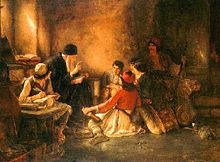
- 1885 Prominent Greek painter Nicholaos Gysis paints the famous "Secret school" ("κρυφό σχολειό"), refering to the underground schools provided by the Greek Orthodox Church in monasteries and churches during the time of Ottoman rule in Greece (15th-19th c.) for keeping alive Orthodox Christian doctrines and Greek language and literacy.
- 1888 Typikon of the Great Church of Christ is published with revised church services, prepared by Protopsaltis George Violakis, issued with the approval and blessing of the Ecumenical Patriarch, while the Sabaite (monastic) Typikon continues to be used in Russia (i.e. from 1682-1888 the Greek and Russian Churches had shared a common Typikon); death of Panagis of Lixouri (Cephalonia).
- 1890-1917 Emigration of 450,000 Greeks to the United States, many as hired labor for the railroads and mines of the American West.
- 1894 On March 8th, Nektarios of Pentapolis was appointed Dean of the Rizarios Ecclesiastical School, remaining as Dean until 1908, becoming a spiritual guide to many.
- 1897 Greco-Turkish War.
- 1901 "Evangelakia" riots in Athens Greece in November, over translations of New Testament into Demotic (Modern) Greek, resulting in fall of both government and Metropolitan of Athens, and withdrawal of publications from circulation.
- 1902 Church of Greece takes responsibility for Greek Orthodox parishes in Australasia from the Church of Jerusalem.
- 1904 Ecumenical Patriarchate publishes the "Patriarchal" Text of the Greek New Testament, based on about twenty Byzantine manuscripts, the standard text of the Greek-speaking Orthodox churches today.
- 1904-1910 Nektarios of Pentapolis began building the Convent of the Holy Trinity on the island of Aegina, while yet Dean of the Rizarios School.
- 1905 Death of Apostolos Makrakis.
- 1907 Archim. Eusebius Matthopoulos founds Zoe Brotherhood.
- 1908 Death of Methodia of Kimolos; jurisdiction of the Greek Church in America and the Greek Church in Australia was given to the Church of Greece under an agreement made between the Ecumenical Patriarchate and the Holy Synod of Athens (until 1922 in America; until 1924 in Australia); Nektarios of Pentapolis took up permanent residence on Aegina, where he spent the last years of his life, devoting himself to the direction of his convent and to very intense prayer.
- 1912 Balkan Wars: Epirus, Macedonia and eastern Aegean islands are liberated and come under the administration of the Greek Church, but remain under the nominal authority of the Patriarch of Constantinople.
- 1914-18 World War I.
- 1913-14 Greeks anex Crete, Chios and Mytiline.
- 1914 According to the Corfu Protocol Northern Epirus is granted autonomy within Albania; Byzantine & Christian Museum is founded in Athens, becoming one of the most important museums in the world in Byzantine Art.
- 1917 Hierarchy of the Greek Church changed in accordance with political control of the country.

- 1918 The "St. Sophia Redemption Committee" is formed in Britain after the Armistice, whose members included two future Foreign Secretaries and many prominent public figures, seeking to restore Hagia Sophia into an Orthodox Church (1918-1922);[13] Roman Catholic opposition to the St Sophia Redemption Committee included Msgr. Manuel Bidwell (Chancellor of the Archdiocese of Westminster) who was on the initial committee, British MP Sir Stuart Coats also on the committee, Cardinal Pietro Gasparri the Papal Secretary of State, and the Vatican who wished to block St. Sophia becoming a Greek Orthodox Church (according to the Grand Vizier of Constantinople who had an offer of Papal support).[14][note 4]
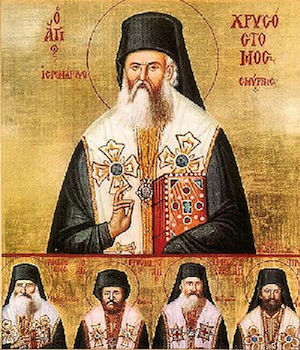
* Chrysostomos (Kalafatis) of Smyrna (†1922);
* Ambrosios of Moschonision;
* Euthymios (Agritellis) of Zela (†1921);
* Gregorios of Kidonion (†1922);
* Procopius of Iconium.
- 1918-1923 Allied Occupation of Constantinople.
- 1918-24 Emigration of 70,000 Greeks to the United States.
- 1919-22 Greco-Turkish War; a million refugees flee to Greece joining half a million Greeks who had fled earlier; Greek Genocide eliminates the Christian population of Trebizond and Anatolia.
- 1920 Death of Nektarios of Pentapolis (Aegina); St. Nektarios lived on Aegina for 13 years, and was buried in the precinct of the church that he founded; Chryssanthos, Bp. of Trebizond is condemned to death in absentio by a Court Martial in Ankara; Dodecanese Islands ceded to Greece by Italy; publication of Encyclical Letters by Constantinople on Christian unity and on the Ecumenical Movement; Treaty of Sèvres cedes Eastern Thrace and Ionia (Zone of Smyrna) to Greece, but is superceded in 1923 by the Treaty of Lausanne by which these areas were again lost.
- 1921 Greek Orthodox Archdiocese of North and South America formally formed; martyrdom of Bp. Euthymios (Agritellis) of Zela, the last Bishop of the Diocese of Zela on the Pontus.
- 1922 Metropolis of Aitolia and Akarnania founded in its modern form; death of Ethnomartyr Metropolitan Chrysostomos (Kalafatis) of Smyrna, lynched by a Turkish mob incited by Nureddin Pasha on Sunday September 10; Greek troops advancing on Constantinople are routed by Turks; the predominatly Orthodox Christian city of Smyrna is destroyed, ending 1900 years of Christian civilization; Patriarch Meletios IV transferred the Greek Orthodox Archdiocese of America from the Church of Greece back to the jurisdiction of the Church of Constantinople.
- 1923 Exchange of Christian and Moslem population between Greece and Turkey; Treaty of Lausanne affirmed the international status of the Ecumenical Patriarchate, with Turkey guaranteeing respect and the Patriarchate’s full protection, also granting control of the Holy Mountain to Greece; Patriarch ceases to be regarded as head of the Christian Orthodox Millet (millet-i Rûm) in Turkey; Patriarch Meletios Metaxakis promulgates reformed calendar (Revised Julian).
- 1924 Greek Orthodox Archdiocese of Australia formally founded; death of Arsenios the Cappadocian.
Second Hellenic Republic (1924-1935)
- 1924 Death of Arsenios of Cappadocia; Constitution of the Holy Mountain agreed; Greek government adopts new calendar.
- 1925 School of Theology established at the Aristotle University of Thessaloniki.
- 1925-45 Emigration of less than 30,000 Greeks to the United States, many of whom were "picture brides" for single Greek men.
- 1926 Proposal for Mount Athos to be turned into a Casino by Dictator Pangalos.
- 1928 The Ecumenical Patriarchate issued a tome by which it ceded to the Church of Greece on a temporary basis 35 of its metropolitan dioceses in northern Greece to be administered by it.
- 1930 Mustapha Kemal Atatürk officially renamed Constantinople to Istanbul, which comes from the Greek expression "eis tin poli" (to the City) .
- 1931 Benaki Museum opens in Athens, housing Byzantine, Post-Byzantine, and Neo-Hellenic ecclesiastical and national art collections.
- 1932 Death of Papa-Nicholas (Planas).
- 1933 Church of Greece bans Freemasonry.
- 1935 Old Calendar schism, when three bishops declared their separation from the official Church of Greece stating that the calendar change was a schismatic act; Greek Old Calendarist groups maintain that they have not separated over a mere calendar, rather that the calendar is a symptom of what has been called "the pan-heresy of ecumenism;" Mustafa Kemal Atatürk, transformed Hagia Sophia into a museum.
Kingdom of Greece Restored (1935-1967)
- 1936 Apostoliki Diakonia of the Church of Greece founded; General Ioannis Metaxas, Prime Minister of Greece during the 4th of August Regime (1936-41), propagated a Third Hellenic Civilization (Ancient Greece and Byzantium being the first two).
- 1938 Death of Silouan of Mt Athos.
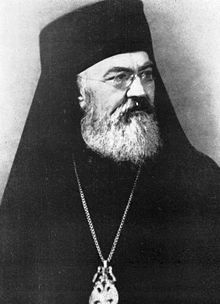
- 1939-49 WWII and subsequent Greek civil war (1942-49), famine and widespread bloodshed.
- 1939 The immigration of the Antiochian Greeks reaches its peak.
- 1943 Massacre of Kalavryta by German occupation forces, including the monks and monastery of Agia Lavra; the Nazi attempt to exterminate the Jews of Athens fails, thanks to the combined efforts of Abp. Damaskinos (Papandreou) of Athens, Greek resistance groups and the Greek people.
- 1945 Abp. Damaskinos (Papandreou) of Athens serves as regent in an attempt to stabilise Greece.
- 1946-82 Approximately 211,000 Greeks emigrated to the United States, especially after 1966, tapering off considerably since the 1980's.
- 1947 The Dodecanese Islands are liberated but remain under the Patriarchate of Constantinople.
- 1948 Death of Savvas the New of Kalymnos.
- 1950 Uncovering of the relics of St. Ephraim of Nea Makri (+1426).
- 1952 New Monastery of Panagia Soumela built in the village of Kastania, in Macedonia, Greece, housing the wonderworking icon of Panagia Soumela, becoming a center of religious pilgrimage.
- 1953 The Athonite School was officially re-established in Mount Athos, now named the ‘Athonite Ecclesiastical Academy’, it occupies a wing of the Skete of St Andrew in Karyes, and follows the Greek secondary school curriculum combined with ecclesiastical education.
- 1955 Istanbul Pogrom: In September in Istanbul an organised mob was turned against the ethnic Greek community and the Ecumenical Patriarchate in an orchestrated pogrom, destroying 73 churches, 1,004 residences, 5,000 small- and medium-sized businesses, two cemeteries, 23 schools and 5 athletic centres; the number of ethnic Greeks who were forced to leave Turkey by 1960 as a result of these events is estimated at around 9,000.
- 1956 Dr. Constantine Cavarnos founds the Institute for Byzantine and Modern Greek Studies in Belmont, Massachusetts.
- 1959 Death of Blessed Elder Joseph (Spilaiotis) the Hesychast.
- 1960 Death of Anthimos of Chios.
- 1961 Glorification of Nektarios of Pentapolis (+1920).
- 1962-68 The 12-Volume "Religious and Ethical Encyclopedia" (Θρησκευτική και Ηθική Εγκυκλοπαίδεια,ΘΗΕ) is compiled as a joint effort between academics, university scholars and other contributors.
- 1963 Soter Brotherhood is created, as the more traditionalist members broke away from the Zoe Brotherhood to form a smaller new brotherhood under the leadership of Prof. Panagiotes N. Trembelas, having a profound influence on the Church of Greece; Second Pan-Orthodox Conference held in Rhodes; 1000th anniversary celebration of founding of Mount Athos.
- 1964 Panagia Malevi icon of the Mother of God begins gushing myrrh; third Pan-Orthodox Conference held in Rhodes; in March Turkey denounced the 1930 bilateral agreement on disputes arising from the exchange of populations and expelled more than 17,000 ethnic Greeks, who were deprived of all access to their real estate, goods and chattels, subsequently followed by the de facto exodus of 40,000 ethnic Greeks of Turkish citizenship.
- 1965 Death of iconographer Photios Kontoglou, who was a strong influence in the reintroduction of traditional Byzantine and postbyzantine style in church iconography; first Metropolitan for Piraeus is elected, His Eminence Chrysostomos (Tabladorakis) of Argolidos; Monastery of Panagia Pantanassa (Kranidiou) founded; Pope Paul VI of Rome and Patriarch Athenagoras I (Spyrou) of Constantinople mutually nullify the excommunications of 1054; the Patriarchal Institute for Patristic Studies is established in Thessaloniki, located at the Holy Patriarchal and Stavropegial Monastery of Vlatadon (Moni Vlatadon).
- 1966 Death of Righteous Father Ieronymos (Apostolides) of Aegina; Center for Byzantine Research established at the Aristotle University of Thessaloniki.
- 1967 Glorification of Arsenios of Paros (+1877) by the Patriarchate of Constantinople.
Military Dictatorship (1967-1974)
- 1968 Orthodox Academy of Crete (OAC) founded by the Archdiocese of Crete, near the Moni Gonia Monastery.
- 1970 Death of Amphilochios (Makris) of Patmos.
- 1971 Halki Seminary, Orthodoxy's most prominent theological school, is closed by Turkish authorities breaching Article 40 of the Lausanne Treaty and Article 24 of the Turkish Constitution which both guarantee religious freedom and education.
- 1972 Ecclesiastical coup in Cyprus fails to remove Makarios from the Presidency; death of missionary Archimandrite Chrysostomos Papasarantopoulos, having laboured to spread the Orthodox faith in Uganda, Kenya, Tanzania, and Congo.
- 1974 Turkish invasion of Cyprus, Turkish forces advance capturing the 37% of the island, 3,000 are killed or missing, 200,000 become refugees; the Monarchy is voted out by a plebiscite vote of 69%.
Third Hellenic Republic (1974-Present)
- 1974 Esphigmenou Monastery (Athos), a stronghold for the conservative Greek Old Calendarists, withdrew its representative from the common meetings of the Holy Community at Karyes (the administrative center of Mount Athos), accusing the Patriarchate of being ecumenist, and refusing to commemorate the Patriarch; Metropolitan Seraphim of Ioannina is elected Archbishop of Athens and all Greece (1974-1998); the Cathedral of Saint Andrew in Patras is inaugurated, being the largest church in Greece, housing the relics of Saint Andrew the Apostle.
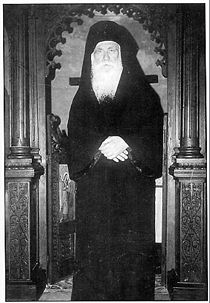
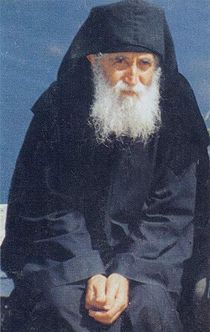
- 1975 Death of Papa-Dimitris (Gagastathis); Article 3 of the Greek Constitution officially declares the prevailing religion in Greece as Eastern Orthodoxy under the authority of the autocephalous Church of Greece, united in doctrine to the Ecumenical Patriarchate.[note 5]
- 1976 The Dimotiki (Demotic) dialect of Modern Greek was made the official language, replacing the purified and formal Katharevousa dialect of Modern Greek which had been in use for nearly two centuries since foundation of the modern Greek state.
- 1978 Abortions are legalised in Greece but only under certain specific circumstances.
- 1980 Death of Elder Philotheos (Zervakos) of Paros; Orthodox-Roman Catholic Joint Commission for Theological Dialogue, 1st plenary, met in Patmos and Rhodes.
- 1981 Greece becomes the 10th member of the European Community, January 1; Adultery is decriminalized in the penal code.
- 1982 Monotonic orthography was imposed by law on the Greek language, however the Greek Orthodox Church continues to use polytonic orthography.
- 1983 Death of Elder Arsenios the cave-dweller of Mt. Athos.
- 1984 Orthodox-Roman Catholic Joint Commission, 3rd plenary, meets in Khania, Crete.
- 1986 Root of Jesse icon of the Mother of God in Andros begins gushing myrrh; glorification of Arsenios the Cappadocian (+1924) by the Patriarchate of Constantinople.
- 1987 In April, parliament approved a law to expropriate monastic land in order to redistribute some to poor peasants, and to take over administration of urban church-owned assets; Abp. Seraphim (Tikas) of Athens was victorious however in preventing the government from expropriating church landholdings, by allowing some land redistribution while opposing nationalisation of church and monastery land.
- 1988 Mount Athos and the Meteora are designated as UNESCO World Heritage sites; radio station "Church of Piraeus 91.2 FM" begins transmitting in October.
- 1989 Elder Ephraim of Philotheou begins founding Athonite-style monasteries in North America.
- 1990 The Friends of Mount Athos society is formed by people sharing a common interest for the monasteries of Mount Athos, with Metr. Kallistos (Ware) of Diokleia being the President of the society, also including Prince Philip (Duke of Edinburgh) and Prince Charles (Prince of Wales and Heir Apparent to the British throne) among its members; the monasteries of Daphni (Athens), Hosios Loukas (Beotia) and Nea Moni of Chios, are designated as UNESCO World Heritage sites.
- 1991 Death of Elder Porphyrios (Bairaktaris) the Kapsokalivite (Evangelos (Bairaktaris)) February 7.
- 1992 Deaths of Gabrielia (Papayannis) and Chrysanthi of Andros; Synaxis of primates of Orthodox churches in Constantinople; Thessaloniki was selected as the cultural capital of Europe (1997).
- 1993 Church of Cyprus condemned Freemasonry as a religion incompatible with Christianity; canonization of Chrysostomos (Kalafatis) of Smyrna.
- 1994 Death of Elder Paisios (Eznepidis) of Mt. Athos July 12; Museum of Byzantine Culture is inaugurated in Thessaloniki; Greek Parliament passes a resolution affirming the genocide in the Pontus region of Asia Minor and designated May 19 a day of commemoration; the Liaison Office of the Orthodox Church to the European Union was established by the Holy and Sacred Synod of the Ecumenical Patriarchate in Brussels.
- 1995 Death of Eldress Macrina of Volos; Ecumenical Patriarch Bartholomew I visits Patmos as part of the celebration of the 1,900th anniversary of the writing of the Book of Revelation by the Evangelist John.
- 1997 A bomb explodes at the Patriarchate of Constantinople, seriously injuring Orthodox deacon Nectarius Nikolou and damaging several buildings.
- 1998 Death of Elder Ephraim of Katounakia; Thessaloniki Summit held to discuss Orthodox participation in WCC; Archbishop Christodoulos (Paraskevaides) was enthroned in Athens as the new head of the Greek Orthodox Church (1998-2008); a proposal to force the separation of church and state in Greece was rejected; Greek parliament affirmed the genocide of Greeks in Asia Minor as a whole (Pontian and Anatolian Ottoman Greeks), and designated September 14 a day of commemoration; on December 8 the Bioethics Committee of the Church of Greece was appointed, to study in depth contemporary bioethical problems from a scientific viewpoint based on Orthodox ethos and the theological perception of man, society and values; posthumous recognition by the State of Israel of Metr. Joachim (Alexopoulos) of Demetrias for saving the lives of 700 people during WWII who were hidden by the residents of the villages of Mount Pelion, having his name inscribed in the Holocaust Museum in Washington, and entered on the Righteous Honor Wall at Yad Vashem in Jerusalem.

- ca.2000 Notable Greek Orthodox modern writers of the younger generation include: Metr. John Zizioulas of Pergamon, Archimandrite Vasileios Gontikakis, Prof. Christos Yannaras, Prof. Fr. John S. Romanides (+2001), Bp. Hierotheos (Vlachos) of Nafpaktos, Protopresbyter Nikolaos Loudovikos, Protopresbyter George Metallinos, Protopresbyter Theodore Zisis, and Panayiotis Nellas, among others.
- 2000 Government of Greece orders removal of compulsory reference to religious affiliation on state identity cards, despite campaigns against this from the Church of Greece and the majority of the public.
- 2001 Death of Elder Haralambos Dionysiatis, teacher of noetic prayer; on the first trip to Greece by a Pope since AD 710, Pope John Paul II of Rome apologizes to Orthodox Church for Fourth Crusade; a day earlier some 1,000 Orthodox conservatives took to the streets to denounce his visit; in March, Abp. Christodoulos (Paraskevaides) of Athens blessed the Hellenic Genocide Petition Effort, which urged that the government not violate Law 2675/98 by deleting the term "genocide" when explaining the destruction of Hellenism in Asia Minor; Abp. Christodoulos (Paraskevaides) of Athens visits the Patriarchate of Moscow, being also received by Russian President Vladimir Putin.
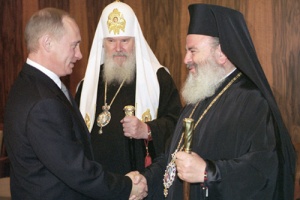
- 2002 The Holy Synod of the Church of Greece rejected a proposal to introduce Modern Greek into the Divine Liturgy (similar to what the Second Vatican Council did for the Roman Catholic Church by allowing the use of the vernacular for the Mass), opting to keep Koine Greek as it was spoken 2,000 years ago and used in New Testament texts;[15] Metropolis of Glyfada is established as a new metropolis separating from Metropolis of New Smyrna; Abp. Christodoulos (Paraskevaides) of Athens consented to the construction of a mosque in Athens to end the situation of the Greek capital being the only EU capital without a Muslim place of worship; Ecumenical Patriarch Bartholomew I of Constantinople declared the monks of Esphigmenou Monastery (Athos) as being in schism with the Orthodox Church.
- 2003 Orthodox Churches in Europe commemorated the 550th anniversary of the fall of Constantinople in May; the Greek Minister of Culture Evangelos Venizelos informs Europarliament session that the status of the monasteries on Holy Mount Athos and its way of life will remain unchanged, citing official recognition of this status fixed in Article 105 of the Greek Constitution and also legally confirmed in the special Athens Treaty clause specifying conditions on which Greece joined the European Union; in February, the Holy Synod of the Greek Orthodox Church issued a statement opposing the threat of war in Iraq.
- 2003 Abp. Christodoulos (Paraskevaides) of Athens has falling out with Ecumenical Patriarch Bartholomew over who should have the final say in the appointment of bishops in northern Greece, but rift is mended four months later; the proposal to build a mosque outside Athens before the 2004 Olympics was blocked due to opposition from residents and Greece's Orthodox Church which disagreed with the location and plans for the funding for the multimillion-pound mosque to come from Saudi Arabia's King Fahd; Abp. Christodoulos (Paraskevaides) of Athens inaugurated the Office of the Representation of the Church of Greece to the European Union in Brussels.
- 2004 In September, a helicopter carrying Patr. Petros VII (Papapetrou) of Alexandria along with 16 others (including 3 other bishops of the Church of Alexandria) crashed into the Aegean Sea while en route to the monastic community of Mount Athos with no survivors.
- 2005 Church of Greece hosted the WCC World Conference on Mission and Evangelism in Athens, the first in an Orthodox country in the history of this body; in October, the "Grey Wolves" Turkish terrorist group staged a rally outside the Ecumenical Patriarchate in Phanar, proceeding to the gate where they laid a black wreath, chanting "Patriarch Leave" and "Patriarchate to Greece", inaugurating the campaign for the collection of signatures to oust the Ecumenical Patriarchate from Istanbul; Britain's Prince Charles arrived on the monastic community of Mount Athos for a three-day visit in May; Vladimir Putin becomes the first Russian state leader to visit Mount Athos.
- 2006 Abp. Christodoulos (Paraskevaides) of Athens visits Vatican, the first head of the Church of Greece to visit the Vatican, reciprocating the Pope's visit to Greece in 2001, signing a Joint Declaration on the importance of the Christian roots of Europe and protecting fundamental human rights; government of Greece announces it will fund and build a €15 million (US$19 million) new mosque in Athens, to be the the first working mosque in the Greek capital since the end of Ottoman rule over 170 years prior, welcomed by Abp. Christodoulos (Paraskevaides) of Athens and the Church of Greece in accordance with its established position; Abp. Christodoulos (Paraskevaides) of Athens castigated globalisation as a "crime against humanity"; Prime Minister Costas Karamanlis goes on a three-day pilgrimmage to Mount Athos; Pope Benedict XVI met with Greek Orthodox Seminarians from the Apostoliki Diakonia theology college in Greece who were visiting Rome, urging them to confront the challenges that threaten the faith by working to unify all Christians; a ruling by a first-instance court in Athens approved the formation of an association of people who worship the 12 gods of Mount Olympus, linked to New Age practises by the Church of Greece.
- 2006 The church reported that there were 216 men’s monastic communities and 259 for women along with 66 sketes, with a total of 1,041 monks and 2,500 nuns, witnessing to a modern modest revival in monasticism; in September, barely 48 hours after a Somali Islamic cleric called for Muslims to kill the Pope, Abp. Christodoulos (Paraskevaides) of Athens told a sermon in Athens that Christians in Africa were suffering at the hands of "fanatic Islamists", citing the example of Roman Catholic monks who were slaughtered the previous year "because they wore the cross and believed in our crucified Lord"; Abp. Christodoulos (Paraskevaides) of Athens criticized the authors of a state issued elementary school sixth grade history textbook, as attempting to conceal the Church's role in defending Greek national identity during Ottoman occupation, the book being later removed in 2007;[note 6] death of Elder Athanasios Mitilinaios, having authored thousands of recorded lectures in the spirit of patristic traditional Orthodoxy.
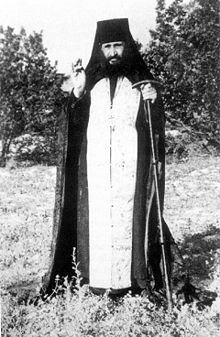
- 2007 Greek Minority Lyceum at the Phanar (Megali tou Genous Sxoli - today a middle and high school of the Greek minority) wins a judgement condemning Turkey at the European Court of Human Rights (ECHR), for violation of the European Convention On Human Rights (protection of property); 1600th anniversary celebration of the repose of John Chrysostom; the International Association of Genocide Scholars passed the IAGS Resolution on Genocides Against Assyrians, Greeks, Armenians, and Other Christians by the Ottoman Empire 13 July 2007, affirming that the Ottoman campaign against Christian minorities between 1914-1923 was genocide; a half-finished painting in the Church of the Holy Virgin in Axioupolis, northern Greece, of Russian communist leader Vladimir Lenin cutting off the beard of St Luke - painted as a symbol of communist oppression of the Church - offended traditionalists who wanted it removed.
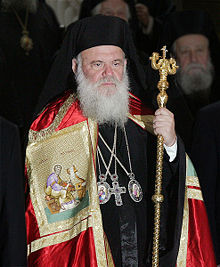 Archbishop Ieronymos II of Athens, (2008-Present).
Archbishop Ieronymos II of Athens, (2008-Present). - 2008 Death of Abp. Christodoulos (Paraskevaides) of Athens, proving to be one of the most popular archbishops in Greek history, reviving the appeal of the Church in a secular age, especially among young people; Abp. Ieronymos II (Liapis) of Athens elected; Glorification of George (Karslidis) of Drama (+1959); Pan-Orthodox meeting in Constantinople in October of the Primates of the fourteen Orthodox Churches, signing a document calling for inter-orthodox unity and collaboration and "the continuation of preparations for the Holy and Great Council"; the 13-member standing committee of the Church of Greece denounced government plans to introduce a civil partnerships law, saying government support for common law marriage would amount to state-sanctioned “prostitution.”
- 2009 The European Court on Human Rights (ECHR) ruled that Turkey violated the property rights of the Bozcaada Kimisis Teodoku Greek Orthodox Church on the Aegean island of Bozcaada; the Ecumenical Patriarchate has filed more than two dozen cases with the ECHR to recover some of the thousands of properties it has lost; US President Barack Obama made an explicit appeal in his speech to the Turkish Parliament for the reopening of the hotly contested Greek Orthodox seminary on Halki, viewed by the European Union and others as a test case for religious freedom in Turkey; a delegation from the Orthodox Church of Greece headed by Metropolitan Nectarios of Kerkira, Paxoi and Diapontioi Nisoi visited several monasteries in West Ukraine; Patr. Mor Ignatius Zakka I Iwas of the Oriental Church of Antioch went on an official visit to Greece, as the guests of the Greek Government and the Greek Orthodox Church to congratulate the new Abp. of the Greek Church and to renew the relationship between both churches; Elder Joseph of Vatopedi reposes peacefully, funeral service held July 1; Russian Orthodox Patr. Kirill called on Turkish authorities to re-open the Theological Seminary on Halki; over 1,000 Muslims rallied in the city streets of Athens over unsubstantiated claims that Greek police allegedly tore up and trampled on the Quran, smashing 75 cars, injuring 14 people, overturning trash bins and attacking banks; a group of Orthodox clergy in Greece, led by three senior archbishops, published a manifesto, A Confession of Faith Against Ecumenism, pledging to resist all ecumenical ties with Roman Catholics and Protestants, amongst its signatories including six metropolitans, as well as 49 archimandrites, 22 hieromonks, and 30 nuns and abbesses, as well as many other priests and church elders.
- 2010 On Sunday, August 15, 2010 Ecumenical Patriarch Bartholomew I conducted the first Divine Liturgy in 88 years at the historic monastery of Panagia Soumela in Trapezounta, northeastern Turkey, marking the first official religious service carried out at the ancient monastery since the foundation of the modern Turkish Republic; death of Metr. Augustinos (Kantiotes) of Florina, a prolific spiritual writer and defender of traditional Orthodox theology; Thyranoixia service of the Church of St. John Vatatzes the Merciful, in Didymoteicho.
- 2011 March 4 Glorification of Ephraim of Nea Makri (+May 5, 1426); On Sunday 3 April 2011, at 9:30 pm, in the Church of the Holy Trinity in Kalymnos, the face of Christ crowned with thorns appeared in the icon of the Virgin Mary on the iconostasis;[note 7] canonization of 1241 New Martyrs of Naoussa, Greece, massacred by the Ottoman Turks from Thursday of Bright Week to the Sunday of Thomas in 1822.[16][17]
See also
- Timeline of Orthodoxy in America
- Timeline of Orthodoxy in Australia
- Timeline of Orthodoxy in Britain
- Timeline of Orthodoxy in China
- Timeline of Orthodoxy in New Zealand
- Timeline of Orthodoxy in Japan
- Timeline of Orthodox Church and Roman Catholic relations
Wikipedia
Notes
- ↑ "According to several accounts, from the Conquest of Constantinople to the last phase of the Greek War of Independence, the Ottoman Turks condemned to death 11 Ecumenical Patriarchs of Constantinople, nearly 100 bishops, and several thousands of priests, deacons and monks (Bompolines, 1952; Paparounis, no date; Perantones, 1972; Pouqueville, 1824; Vaporis, 2000)."
- ↑ Patriarchate of Rome
The Byzantine "themes" of Greece rebelled against the iconoclast emperor Leo III in 727 and attempted to set up their own emperor, although Leo defeated them. Up to this time Greece and the Aegean were still technically under the ecclesiastic authority of the Pope, but Leo also quarreled with the Papacy; the defiant attitude of Popes St. Gregory II and St. Gregory III, who summoned councils in Rome to anathematize and excommunicate the iconoclasts (730, 732) on behalf of image-veneration, led to a fierce quarrel with the emperor. Leo retaliated however by transferring the territories of southern Italy, Greece and the Aegean from the papal diocese to that of the the Patriarch of Constantinople, in effect throwing the Papacy out of the Empire.
Previously the lands which Leo ΙΙΙ now placed under the authority of the Church of Constantinople, although subject to the civil rule of the emperor of Constantinople ever since the end of 395, had nevertheless depended upon Rome ecclesiastically, except for a few brief interruptions including:- In 421 (when a decree enacted by Emperor Theodosius II placed all churches within the pale of the Illyricum prefecture (then part of the Eastern Empire) subject to the Archbishop of Constantinople).
- In 438, through the Theodosian Codex, Illyricum was again placed under Constantinopolitan jurisdiction.
- To some extent during the Acacian schism, 484-519.
The Prefecture of Illyricum was named after the former province of Illyricum and was one of the four principal divisions of the Empire instituted by Diocletian. It originally included two dioceses, the Diocese of Pannoniae and the Diocese of Moesiae. The Diocese of Pannoniae did not belong to the cultural Greek half of the empire, and it was transferred to the western empire when Theodosius I fixed the final split of the two empires in 395. The Diocese of Moesiae (later split into two dioceses: the Diocese of Macedonia and the Diocese of Dacia) was the area known as "Eastern Illyricum", and in view of the detailed list of provinces given by Pope Nicholas Ι (858-67) in a letter in which he demanded the retrocession of the churches removed from papal jurisdiction in 732-33, this area seems to have been the region affected by Emperor Leo's punitive action.- The Diocese of Macedonia consisted of seven provinces: Achaia, Creta, Thessalia, Epirus vetus, Epirus nova, Macedonia Prima, Macedoniae salutaris (Secunda).
- The Diocese of Dacia consisted of five provinces: Dacia mediterranea, Dacia ripensis, Moesia Prima, Dardania, Praevalitana.
- ↑ Ieronymos Agathangelos flourished in 1279 AD. He was a priest-monk and confessor, born in Rhodes. He lived in a cenobitic monastery for 51 years. In his 79th year of age he was, as he says, at Messina of Sicily, and at dawn on the Sunday of Orthodoxy he experienced a majestic vision by which several prophecies were foretold him.
- ↑
Coats pointed out that in 1453 Constantinople had officially been in communion with Rome as a Uniate church. As such, he argued, St. Sophia should continue as a Greek Rite Uniate Church. Cardinal Gaspari gave an interview to the French press while in Paris to observe the peace negotiations, explaining that from Rome's viewpoint the great church had been catholic longer than anything else, being only in schismatic hands from the time of Michael Cerularius to the Council of Florence. The Grand Vizier of Constantinople indicated to the British that he had an offer of Papal support, as the Vatican wished to block St. Sophia becoming a Greek Orthodox Church. The Rev. J.A. Douglas, a member of the Redemption Committee reported that:
- " 'The traditional diplomacy of the Vatican has certainly laboured for decades under the influence of what would happen if the Oecumenical Patriarch, a dangerous witness against Roman claims, even when half-buried in the slum of the Phanar and paralysed by Turkish tyranny, should emerge and be the symbol of a great and progressive Communion which functioned with glorious St. Sophia as its mother church.' "
- " 'The traditional diplomacy of the Vatican has certainly laboured for decades under the influence of what would happen if the Oecumenical Patriarch, a dangerous witness against Roman claims, even when half-buried in the slum of the Phanar and paralysed by Turkish tyranny, should emerge and be the symbol of a great and progressive Communion which functioned with glorious St. Sophia as its mother church.' "
- ↑ Church and State
The Orthodox Church in Greece has been considered historically as the protector of the so-called “Hellenic Orthodox Civilization.” The actual role of the Orthodox Church since the creation of the Greek nation-state has been interpreted in many diverse and opposing ways; nevertheless, in all Greek Constitutions the Orthodox Church is accorded the status of the “prevailing religion". Article 3 of Greece's Constitution defines the relations between the Church and the State :- "The prevailing religion in Greece is that of the Eastern Orthodox Church of Christ. The Orthodox Church of Greece, acknowledging our Lord Jesus Christ as its head, is inseparably united in doctrine with the Great Church of Christ in Constantinople and with every other Church of Christ of the same doctrine, observing unwaveringly, as they do, the holy apostolic and synodal canons and sacred traditions. It is autocephalous and is administered by the Holy Synod of serving Bishops and the Permanent Holy Synod originating thereof and assembled as specified by the Statutory Charter of the Church in compliance with the provisions of the Patriarchal Tome of June 29, 1850 and the Synodal Act of September 4, 1928." ("Religion of Greece." at Greece Index.)
Greece is the only Orthodox state in the world. The relationship between the Church and the State can be characterized as sui generis, since there is no complete separation nor is there an established church. The Church is the State-Church. The role of the Orthodox Church in maintaining Greek ethnic and cultural identity during the 400 years of Ottoman rule has strengthened the bond between religion and government. Most Greeks, whether personally religious or not, revere and respect the Orthodox Christian faith, attend church and major feast days, and are emotionally attached to Orthodox Christianity as their "national" religion.
- "The prevailing religion in Greece is that of the Eastern Orthodox Church of Christ. The Orthodox Church of Greece, acknowledging our Lord Jesus Christ as its head, is inseparably united in doctrine with the Great Church of Christ in Constantinople and with every other Church of Christ of the same doctrine, observing unwaveringly, as they do, the holy apostolic and synodal canons and sacred traditions. It is autocephalous and is administered by the Holy Synod of serving Bishops and the Permanent Holy Synod originating thereof and assembled as specified by the Statutory Charter of the Church in compliance with the provisions of the Patriarchal Tome of June 29, 1850 and the Synodal Act of September 4, 1928." ("Religion of Greece." at Greece Index.)
- ↑ The infamous school history textbook for 11-year-olds was finally withdrawn by Greece’s new education minister Evripides Stylianides in 2007. Supporters of the textbook denounced its withdrawal as being due to ‘nationalism and religious fundamentalism’, however Greece's Orthodox Church leader and academics correctly identified it as an attempt to rewrite Greek history to make it ‘more inclusive’, in which pivotal events in Greek history – such as the Greek War of independence and the role of the church in the uprising, the burning of Smyrna (1922), the Istanbul pogrom (1955), the Cypriot campaign for enosis and the Turkish invasion and occupation of Cyprus – were omitted or glossed over. Abp. Christodoulos welcomed the news, stating: "The Church was first...to resist this distortion by the doubters of historical facts." (Greece withdraws history text book after complaints from church, academics. IHT. September 25, 2007.)
- ↑ Metropolitan Paisios of Leros and Kalymnos was immediately notified of this and came to the church to see for himself. He told the people that God sends these signs in order to draw His people closer to Him. Thousands of clergy and faithful have come to the church to see this miracle in the middle of Great Lent. It was originally seen by women who were in the church chanting the lamentations to the Virgin Mary. When the image appeared the oil candle above the icon began to move, though the others stood still.
References
- ↑ 1.0 1.1 1.2 1.3 World Council of Churches: Church of Greece.
- ↑ Christodoulos (Paraskevaides) of Athens. Address to the Conference organised by the Synodal Committee on European Issues, entitled “Islam: the extent of the problematics”. Holy Monastery of Penteli, Attica, 12/5/2007.
- ↑ Demetrios Constantelos. Altruistic Suicide or Altruistic Martyrdom? Christian Greek Orthodox Neomartyrs: A Case Study. Archives of Suicide Research, Volume 8, No 1, 2004. (Myriobiblos Library).
- ↑ (Greek) Bompolines, Κ. Α. (1952). The church in the struggle for freedom. Athens: no publisher given.
- ↑ (Greek) Paparounis, Ρ.Ν. (no date). Under Turkish rule. Athens: Ekdoseis Gregoris, pp. 329-348.
- ↑ (Greek) Perantones, Ι.Ρ. (1972). Lexicon of the neοmartyrs. Athens: no publisher is given.
- ↑ (French) Pouqueville. (1824). Histoire de la regeneration de la Grèce. Paris: F. Didot père et fils.
- ↑ Vaporis, Ν.M. (2000). Orthodox Christian neomartyrs of the ottoman period 1437-1860. Witnesses for Christ. Crestwood, ΝΥ: St. Vladimir's Seminary Press.
- ↑ The Globe and Mail (Canada's National Newspaper). "Orthodox Church at Crossroads." November 10, 1995. p.A14.
- ↑ 10.0 10.1 Anthony Kaldellis Associate Professor (Department of Greek and Latin, The Ohio State University), A Heretical (Orthodox) History of the Parthenon, p.3
- ↑ Great Synaxaristes: (Greek) Ὁ Ἅγιος Ἰωάννης ὁ Βατατζὴς ὁ ἐλεήμονας βασιλιὰς. 4 Νοεμβρίου. ΜΕΓΑΣ ΣΥΝΑΞΑΡΙΣΤΗΣ.
- ↑ Sergei Govorun. Indulgences in the history of the Greek Church. Transl. by Bishop Tikhon of San Francisco & the West. 25/11/2004.
- ↑ Prof. Erik Goldstein. Holy Wisdom and British Foreign Policy, 1918-1922: The St. Sophia Redemption Agitation. In Byzantine and Modern Greek Studies Vol.15 (1991): pp.36-64.
- ↑ Prof. Erik Goldstein. Holy Wisdom and British Foreign Policy, 1918-1922: The St. Sophia Redemption Agitation. In Byzantine and Modern Greek Studies Vol.15 (1991): pp.46,47,59.
- ↑ "Greek Orthodox ban modern Greek in liturgy. (News in Brief: Greece)." Catholic Insight. Nov. 2002: 27+.
- ↑ The Canonization of 1241 New Martyrs of Naoussa. Ipernity. July 5, 2011 at 05:38PM.
- ↑ Τελετή αγιοκατάταξης των 1241 νεομαρτύρων της Νάουσας. Romfea.gr. Δευτέρα, 27 Ιούνιος 2011.
Published works
Byzantine Era
- Rev. Dr. Andrew Louth. Greek East and Latin West : The Church, AD 681-1071. The Church in History Vol. III. Crestwood, N.Y. : St. Vladimirs Seminary Press, 2007. ISBN 9780881413205
- Rev. Dr. Andrew Louth and Dr. Augustine Casiday (Eds.). Byzantine Orthodoxies: Papers from the Thirty-Sixth Spring Symposium of Byzantine Studies, University of Durham, 23-25 March 2002. Society for the Promotion of Byzantine Studies, Volume 12. Ashgate Publishing, Ltd., 2006.
- Prof. Donald M. Nicol. Church and Society in Byzantium. Cambridge University Press, 2008. ISBN 0521071674
- Sir Dimitri Obolensky. The Byzantine Commonwealth: Eastern Europe, 500-1453. New York, NY: Praeger Publishers Inc., 1971. ISBN 978-1597407359
- John Meyendorff. The Byzantine Legacy in the Orthodox Church. Crestwood, N.Y. : St. Vladimirs Seminary Press, 1982. ISBN 9780913836903
- John Meyendorff. Byzantine Theology: Historical Trends and Doctrinal Themes. 2nd ed. Fordham Univ Press, 1979. ISBN 9780823209675
- J. M. Hussey. Church & Learning in the Byzantine Empire, 867-1185. Oxford University Press, 1937.
- Joan Mervyn Hussey. The Orthodox Church in the Byzantine Empire. Oxford History of the Christian Church. (First published 1986). Oxford University Press, 1990. ISBN 0198264569
- Joseph Patrich. The Sabaite Heritage in the Orthodox Church from the Fifth Century to the Present. Volume 98 of Orientalia Lovaniensia analecta. Peeters Publishers, 2001. ISBN 9042909765
- Liebeschuetz, John Hugo Wolfgang Gideon. Barbarians and Bishops: Army, Church, and State in the Age of Arcadius and Chrysostom. Clarendon Press, 1990. ISBN 0198148860
- Milton V. Anastos. Aspects of the Mind of Byzantium: Political Theory, Theology, and Ecclesiastical Relations with the See of Rome. Ashgate Publications, Variorum Collected Studies Series, 2001.
- Milton V. Anastos. "The transfer of Illyricum, Calabria, and Sicily to the jurisdiction of the Patriarchate of Constantinople in 732-33." In: Anastos, Studies in Byzantine Intellectual History. Variorum Collected Studies Series, London, 1979.
- Prof. Anthony Kaldellis. A Heretical (Orthodox) History of the Parthenon. Department of Greek and Latin, The Ohio State University. 01/02/2007. (.pdf)
- Prof. Fergus Millar. A Greek Roman Empire: Power and Belief under Theodosius II (408-450). University of California Press, 2007. ISBN 978-0520253919
- Fr. Robert F. Taft (S.J.), Patriarch Athenagoras Orthodox Institute. Through Their Own Eyes: Liturgy as the Byzantines Saw It. InterOrthodox Press, 2006. 172 pp. (ISBN 1932401067; ISBN 9781932401066)
- Speros Vryonis, (Jr). "Byzantine Attitudes towards Islam during the Late Middle Ages." Greek Roman and Byzantine Studies 12 (1971).
- Steven Runciman. The Byzantine Theocracy. Cambridge University Press, 2004. ISBN 9780521545914
- Timothy S. Miller. Medieval Byzantine Christianity. Ed. by Derek Krueger. A People's History of Christianity, Vol. 3. Minneapolis, Fortress Press. 2006. pp.252.
Latin Occupation
- Aristeides Papadakis (with John Meyendorff). The Christian East and the Rise of the Papacy: The Church 1071-1453 A.D. The Church in History Vol. IV. Crestwood, N.Y. : St. Vladimirs Seminary Press, 1994. ISBN 9780881410587
- Deno John Geanakoplos. Byzantine East and Latin West: Two worlds of Christendom in Middle Ages and Renaissance: Studies in Ecclesiastical and Cultural History. Oxford Blackwell 1966. ISBN 9780208016157
- E. Brown. "The Cistercians in the Latin Empire of Constantinople and Greece." Traditio 14 (1958), pp.63-120.
- Gill Page. Being Byzantine: Greek Identity before the Ottomans, 1200-1420. Cambridge University Press, 2008. ISBN 9780521871815
- Joseph Gill. Church Union: Rome and Byzantium, 1204-1453. Variorum Reprints, 1979.
- Kenneth M. Setton. Catalan Domination of Athens, 1311-1388. Mediaeval Academy of America, 1948.
- Kenneth Meyer Setton. The Papacy and the Levant, 1204-1571: The Thirteenth and fourteenth centuries, Volume 1. American Philosophical Society, 1976.
- P. Charanis. "Byzantium, the West and the Origin of the First Crusade." Byzantion 19 (1949), pp.17-36.
- Prof. Tia M. Kolbaba. The Byzantine Lists: Errors of the Latins. 1st Ed. Urbana and Chicago: University of Illinois Press, 2000. 248pp.
- R. Wolff. "The Organisation of the Latin Patriarchate of Constantinople 1204-61." Traditio 6 (1948), pp.33-60.
- William Miller. The Latins in the Levant: A History of Frankish Greece 1204-1566. Cambridge, Speculum Historiale, 1908.
Ottoman Turkish Occupation
- Apostolos E. Vacalopoulos. The Greek Nation, 1453-1669: The Cultural and Economic Background of Modern Greek Society. Transl. from Greek. Rutgers University Press, 1975. ISBN 9780813508108 (One of the few scholarly studies in English of this period)
- Bat Ye'or. The Decline of Eastern Christianity Under Islam: From Jihad to Dhimmitude: Seventh-Twentieth Century. Translated by Miriam Kochan. Published by Fairleigh Dickinson Univ Press, 1996. 522pp. ISBN 9780838636886
- Fr. Nomikos Michael Vaporis. Witnesses for Christ: Orthodox Christian Neomartyrs of the Ottoman Period 1437-1860. St Vladimir's Seminary Press, 2000. 377 pp. ISBN 9780881411966
- George P. Henderson. The Revival of Greek Thought, 1620-1830. State University of New York Press, 1970. ISBN 9780873950695 (Focuses on the intellectual revivial preceeding the War of Independence in 1821)
- George A. Maloney, (S.J.). A History of Orthodox Theology Since 1453. Norland Publishing, Massachusetts, 1976.
- Leften S. Stavrianos. The Balkans Since 1453. Rinehart & Company, New York, 1958.
- Speros Vryonis, (Jr). The Decline of Medieval Hellenism in Asia Minor and the Process of Islamization from the Eleventh through the Fifteenth Century. University of California Press, Berkeley and Los Angeles, 1971. (Very comprehensive, masterpiece of scholarship)
- Steven Runciman. The Great Church in Captivity: A Study of the Patriarchate of Constantinople from the Eve of the Turkish Conquest to the Greek War of Independence. Cambridge University Press,1986.
- Timothy Ware (Bp. Kallistos (Ware) of Diokleia). Eustratios Argenti: A Study of the Greek Church under Turkish Rule. Clarendon Press, 1964. ASIN B0006BMI94 ISBN 0899810233
- Theodore H. Papadopoulos. Studies and Documents Relating to the History of the Greek Church and People Under Turkish Domination. 2nd ed. Variorum, Hampshire, Great Britain, 1990. (Scholarly; Source texts in Greek)
- Articles
- Elizabeth A. Zachariadou. The Great Church in captivity 1453–1586. Eastern Christianity. Ed. Michael Angold. Cambridge University Press, 2006. Cambridge Histories Online.
- Elizabeth A. Zachariadou. Mount Athos and the Ottomans c. 1350–1550. Eastern Christianity. Ed. Michael Angold. Cambridge University Press, 2006. Cambridge Histories Online.
- I. K. Hassiotis. From the 'Refledging' to the 'Illumination of the Nation': Aspects of Political Ideology in the Greek Church Under Ottoman Domination. Balkan Studies 1999 40(1): 41-55.
- Socrates D. Petmezas. Christian Communities in Eighteenth and Early Nineteenth Century Ottoman Greece: Their Fiscal Functions. Princeton Papers: Interdisciplinary Journal of Middle Eastern Studies 2005 12: 71-127.
Greek War of Independence
- David Brewer. The Greek War of Independence : the struggle for freedom from Ottoman oppression and the birth of the modern Greek nation. Woodstock, N.Y. : Overlook Press, 2001. 393pp.
- Douglas Dakin. The Greek struggle for independence, 1821-1833. London, Batsford 1973.
- Joseph Braddock. The Greek Phoenix: The Struggle for Liberty from the Fall of Constantinople to the Creation of a New Greek Nation. NY. Coward, McCann & Geoghegan. 1973. 1st ed. 233pp.
- Nikiforos P. Diamandouros [et al] (Eds.). Hellenism and the First Greek war of Liberation (1821-1830) : Continuity and Change. The Modern Greek Studies Association of the United States and Canada. Thessaloniki: Institute for Balkan Studies, 1976.
Modern Greece
- Anastasios Anastassiadis. Religion and Politics in Greece: The Greek Church's 'Conservative Modernization' in the 1990's. Research in Question, No.11, January 2004. (PDF).
- C.M. Woodhouse. Modern Greece. 4th ed. Boston : Faber and Faber, 1986.
- Charles A. Frazee. The Orthodox Church and independent Greece, 1821-1852. Cambridge University Press 1969.
- Demetrios J. Constantelos. The Greek Orthodox Church: Faith, History, and Practice. Seabury Press, 1967.
- Dimitri E. Conomos, Graham Speake. Mount Athos, the Sacred Bridge: The Spirituality of the Holy Mountain. Oxford: Peter Lang, 2005.
- Effie Fokas. Religion in the Greek Public Sphere: Nuancing the Account. Journal of Modern Greek Studies. Volume 27, Number 2, October 2009, pp.349-374.
- Herman A. Middleton. Precious Vessels of the Holy Spirit: The Lives & Counsels of Contemporary Elders of Greece. 2nd Ed. Protecting Veil Press, 2004.
- John Hadjinicolaou (Ed.). Synaxis: An Anthology of the Most Significant Orthodox Theology in Greece Appearing in the Journal Synaxē from 1982 to 2002. Montréal : Alexander Press, 2006.
- John L. Tomkinson. Between Heaven and Earth: The Greek Church. Anagnosis Books, Athens, 2004. ISBN 960-87186-5-1
- Mother Nectaria McLees. EVLOGEITE! A Pilgrim's Guide to Greece. 1st Ed. St. Nicholas Press, Kansas City, MO, 2002. 927 pp. ISBN 09716365-1-6
- Norman Russell. Modern Greek Theologians and the Greek Fathers. Philosophy & Theology Volume 18, Issue 1. 2007.10.17. Pages 77-92. (ISSN 08902461)
- Rev. Dr. Nicon D. Patrinacos (M.A., D.Phil. (Oxon)). A Dictionary of Greek Orthodoxy - Λεξικον Ελληνικης Ορθοδοξιας. Light & Life Publishing, Minnesota, 1984.
- Rev. A. H. Hore. Eighteen centuries of the Orthodox Greek Church. London: James Parker & Co. 1899. 706pp. (Re-printed: Gorgias Press LLC, 2003.)
